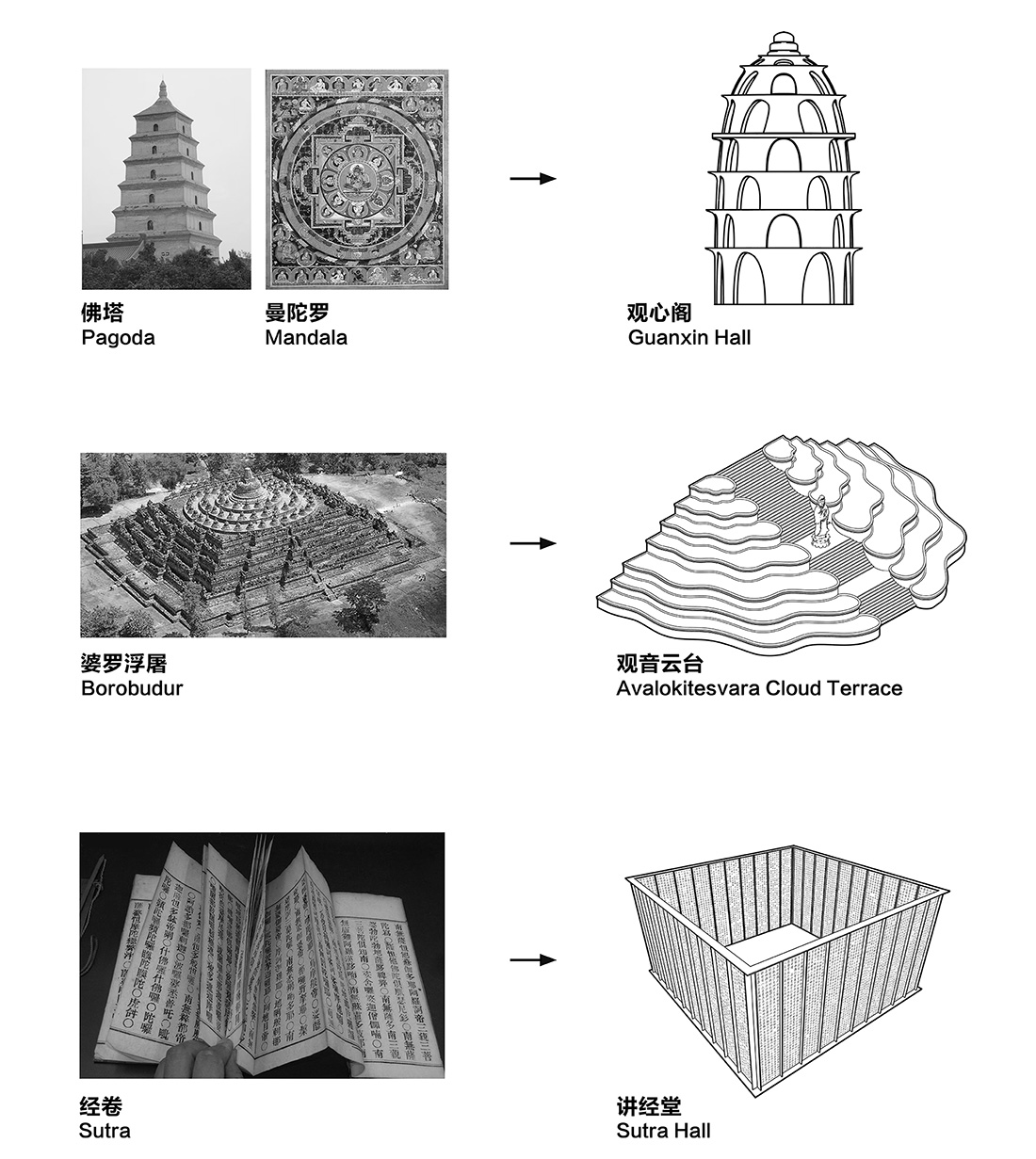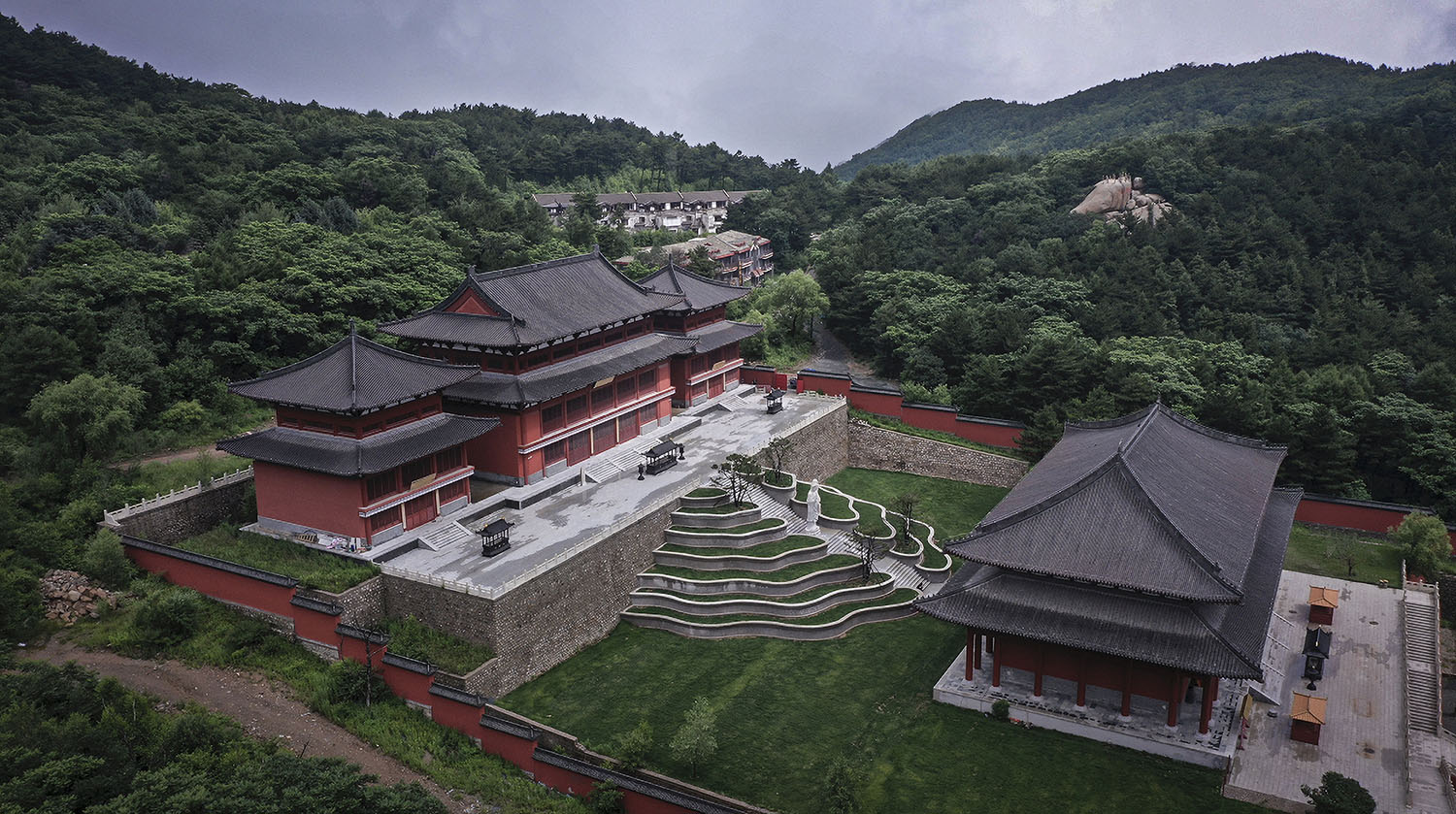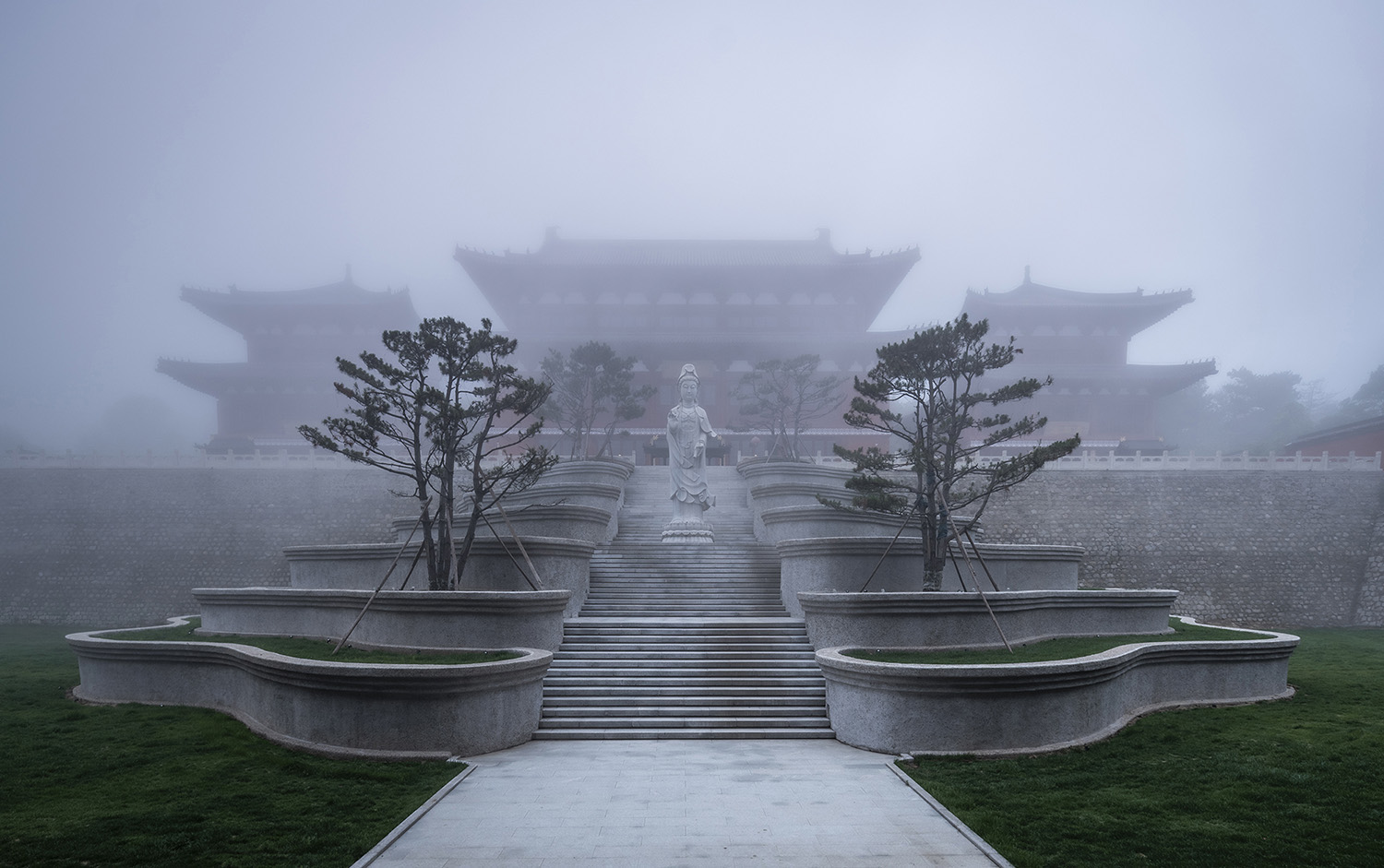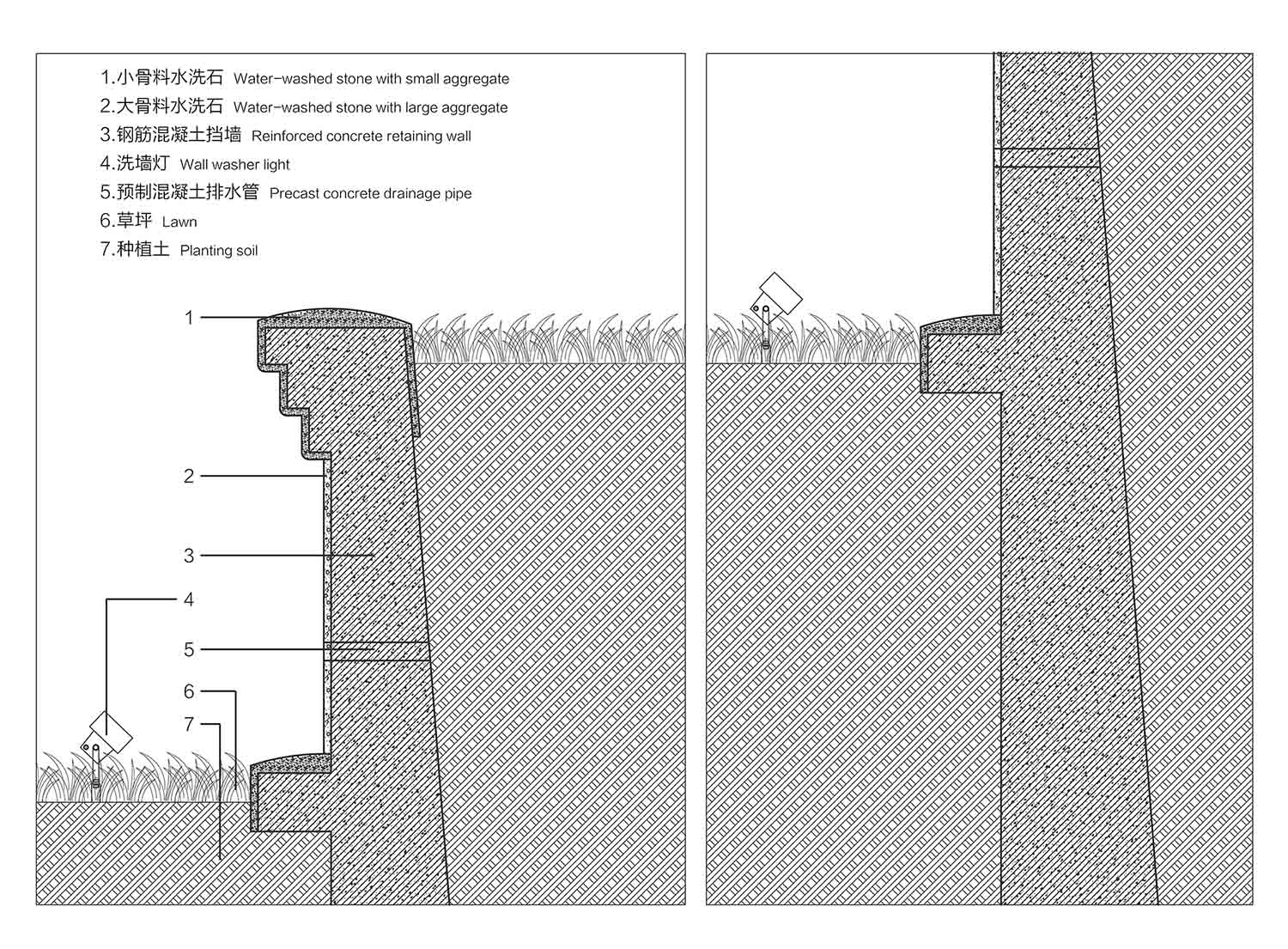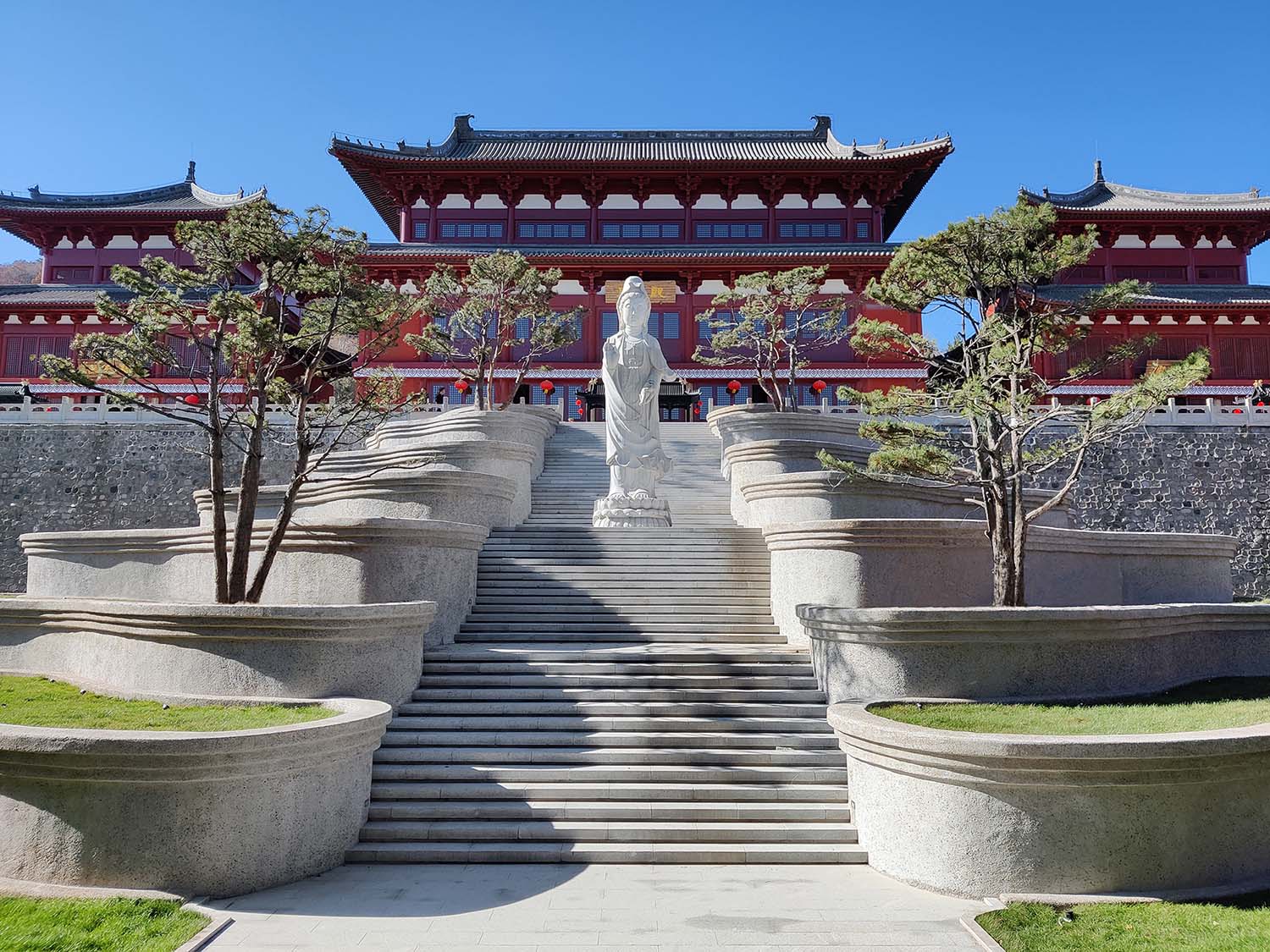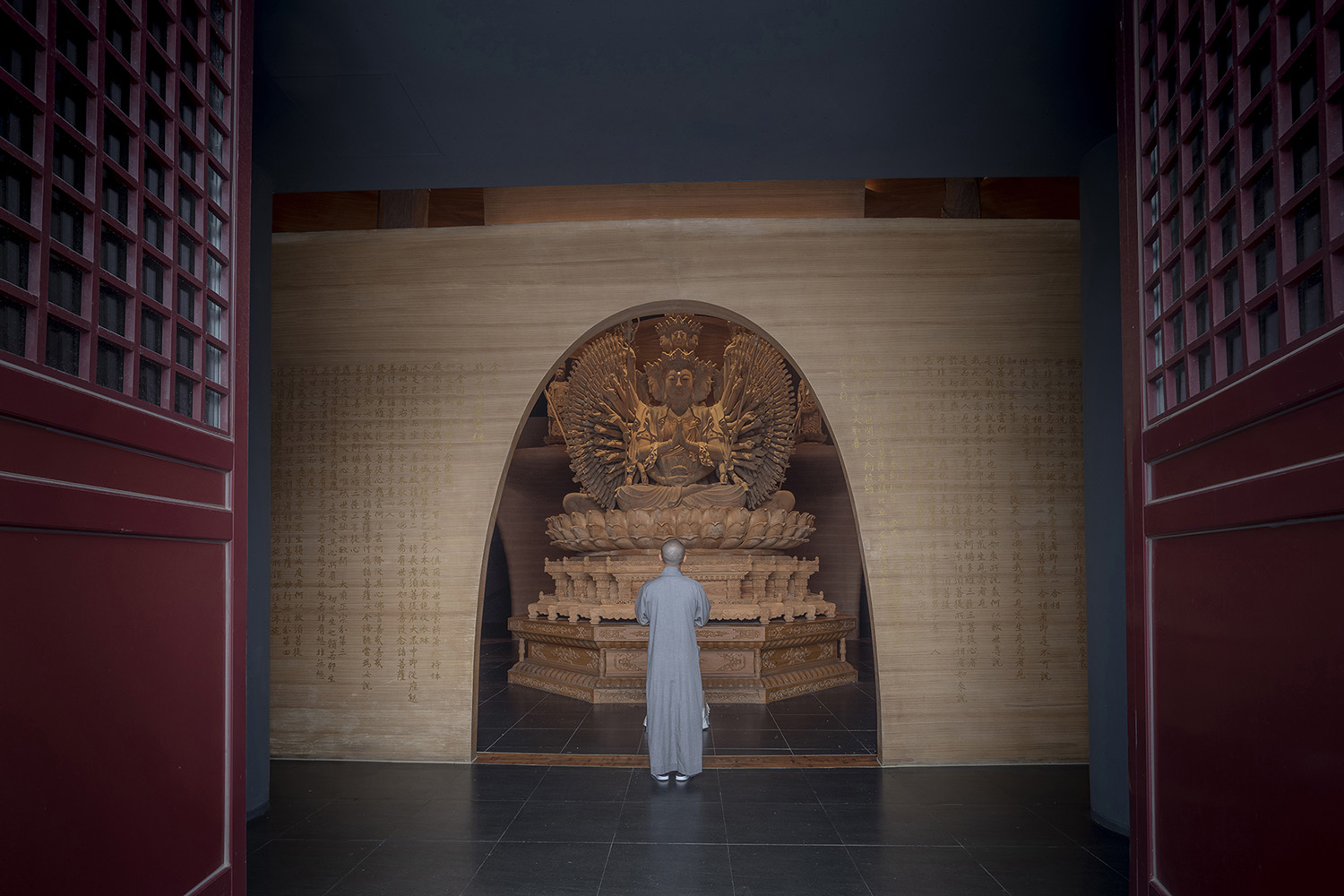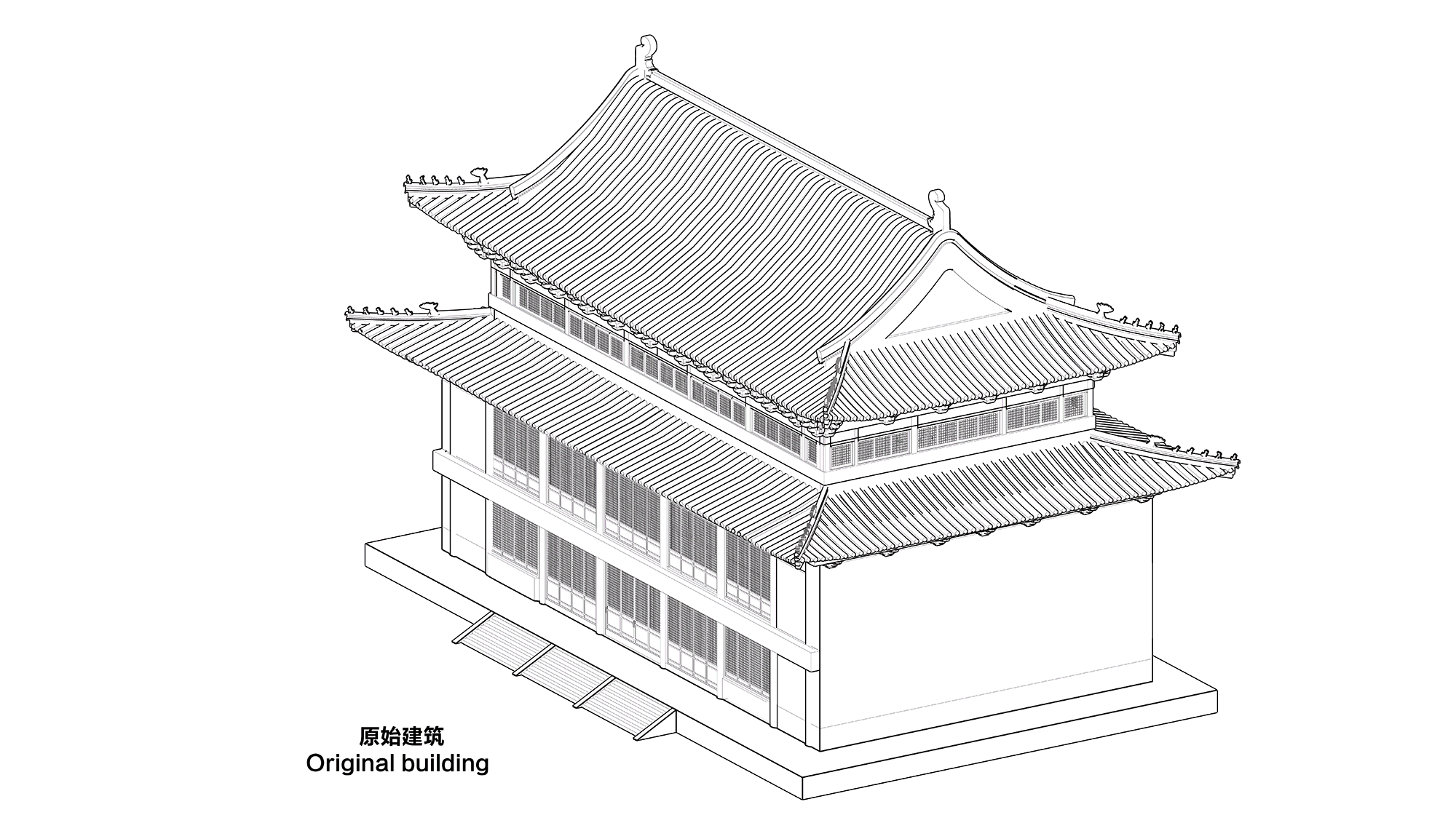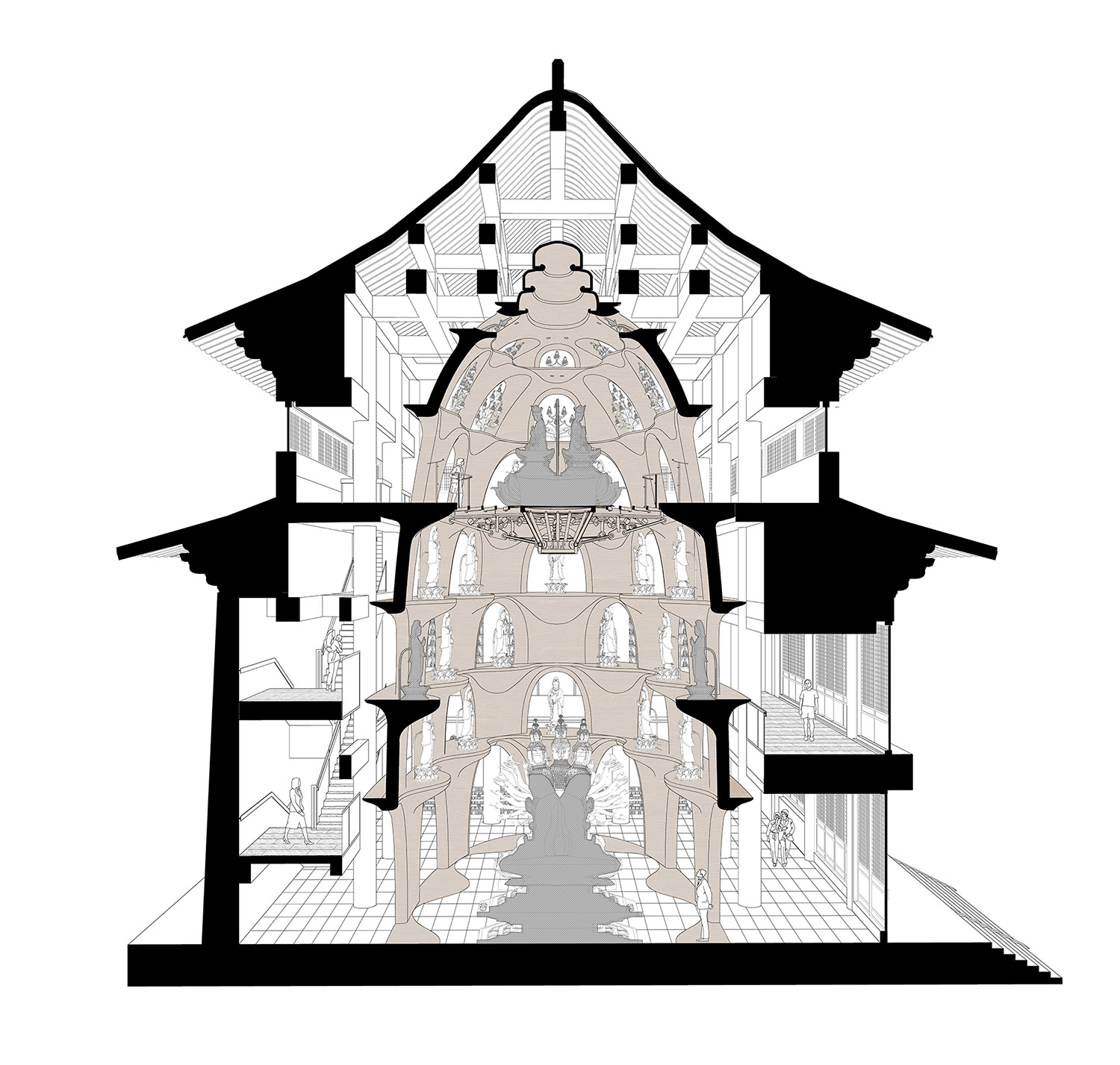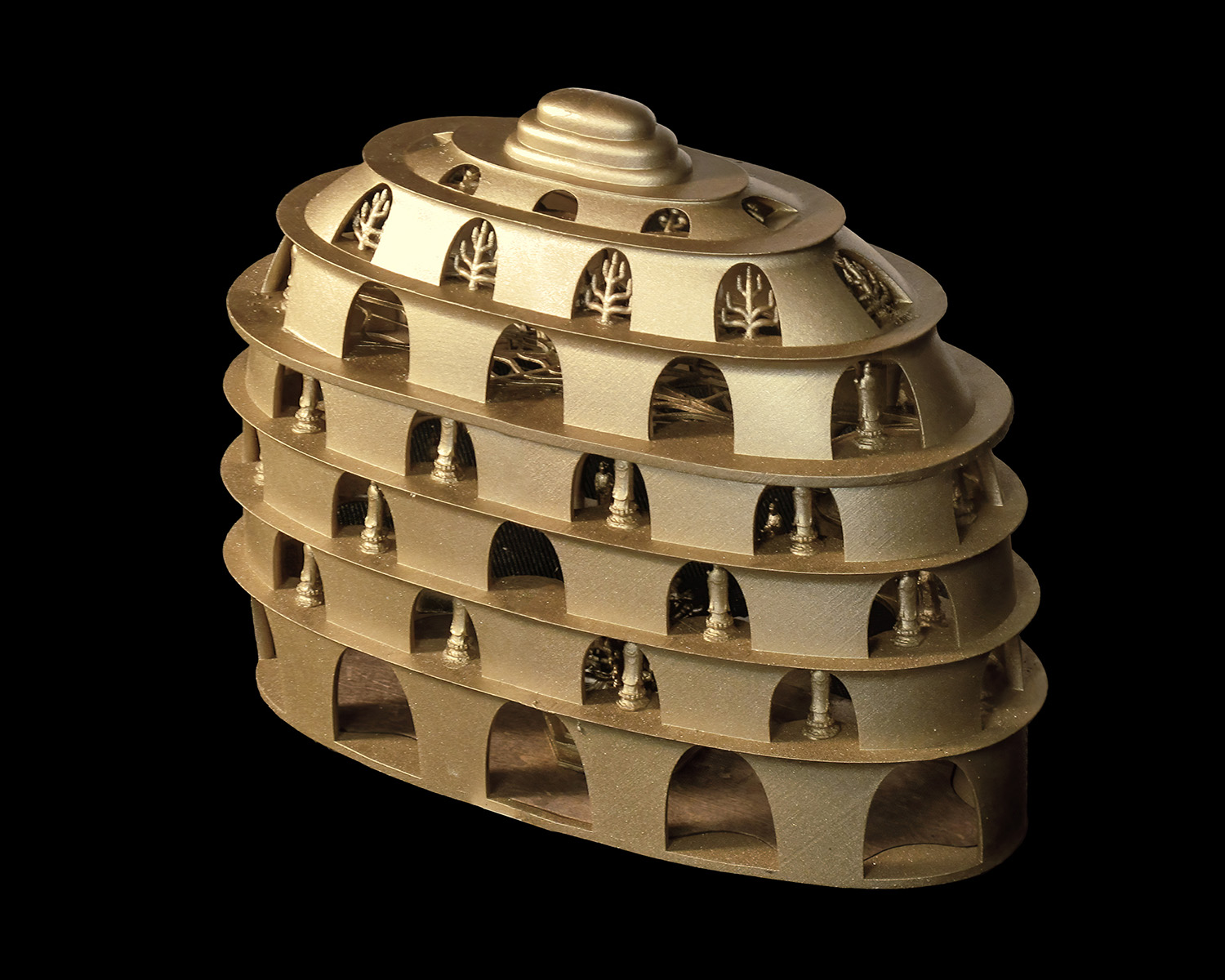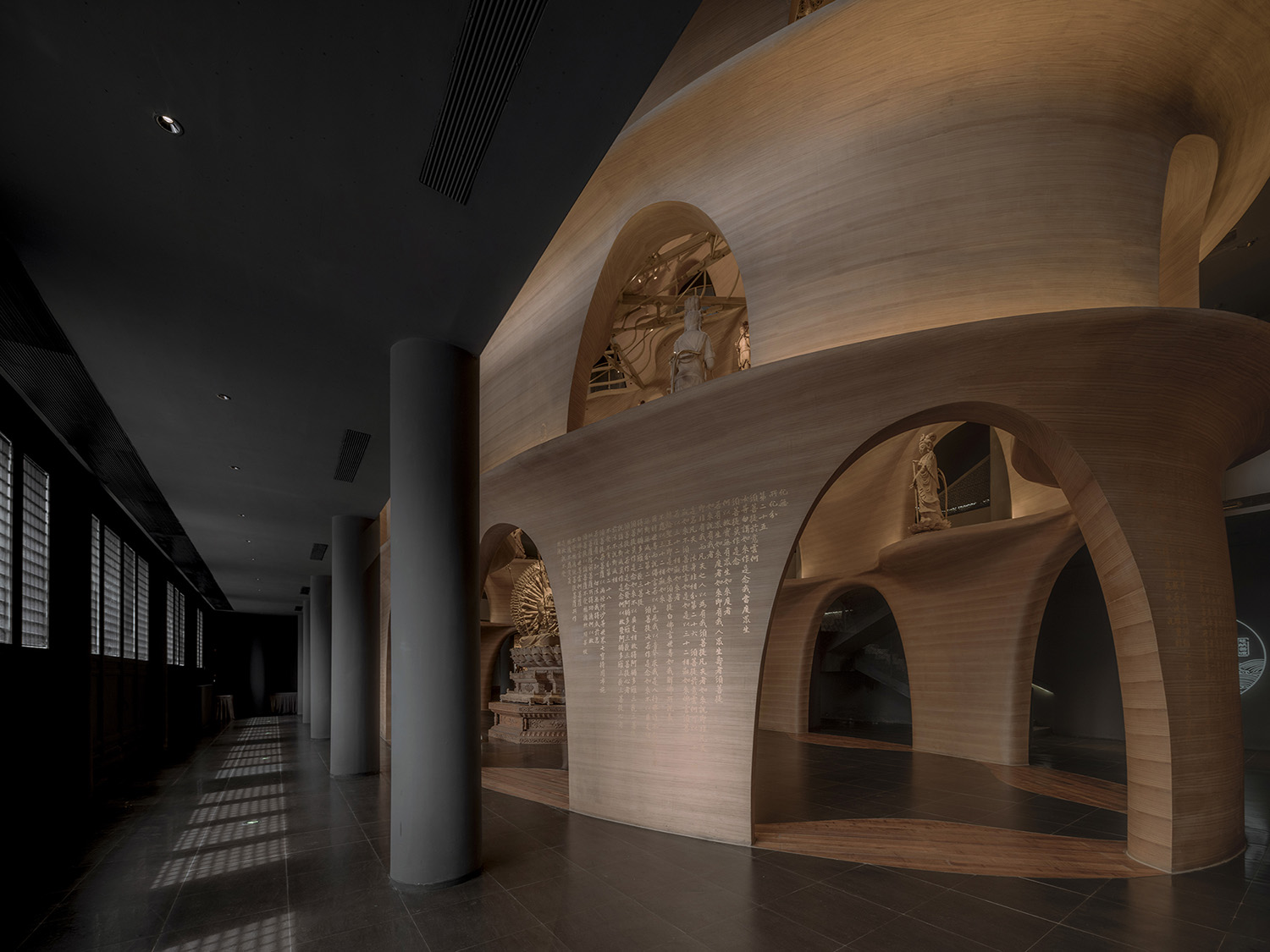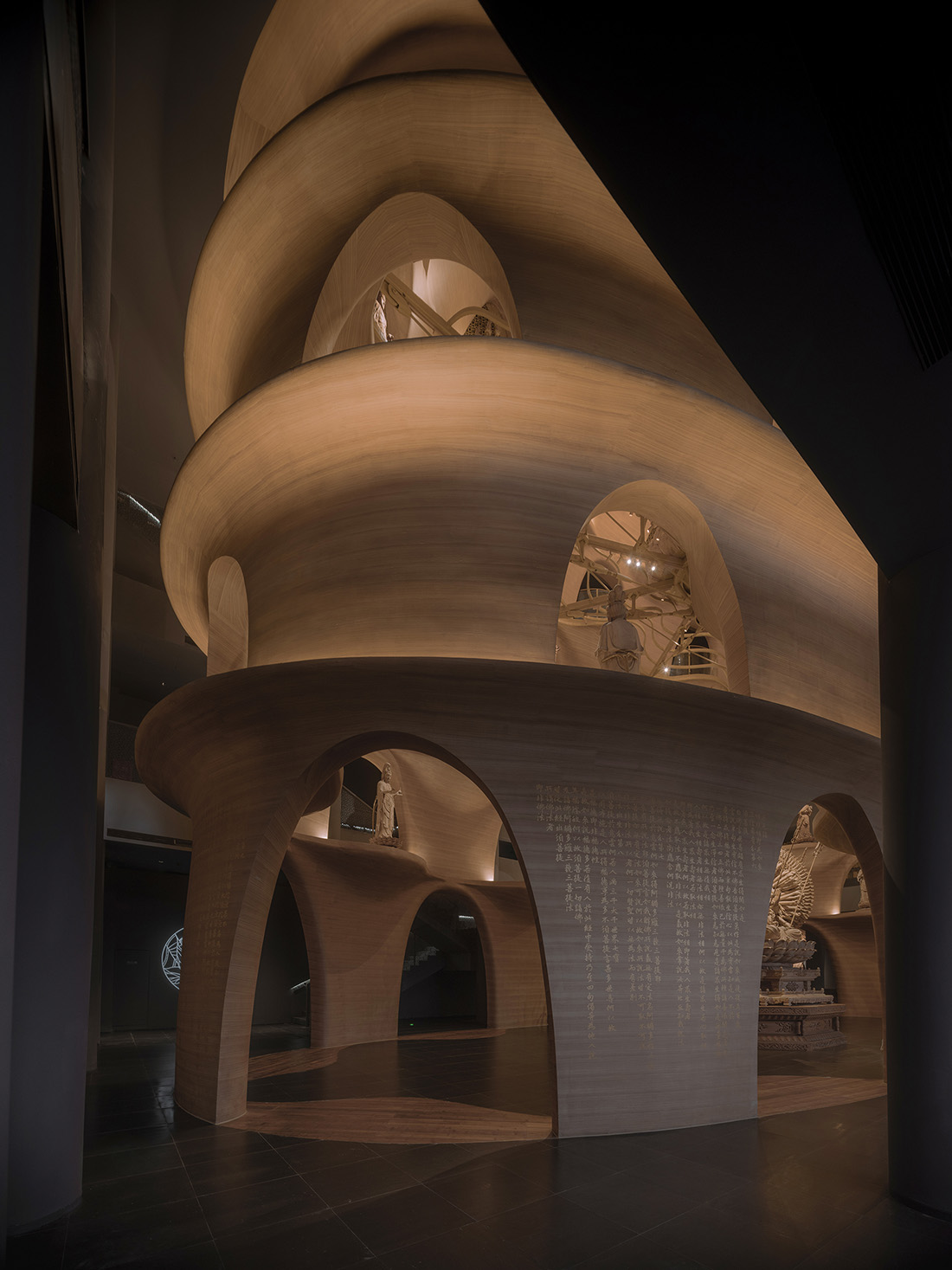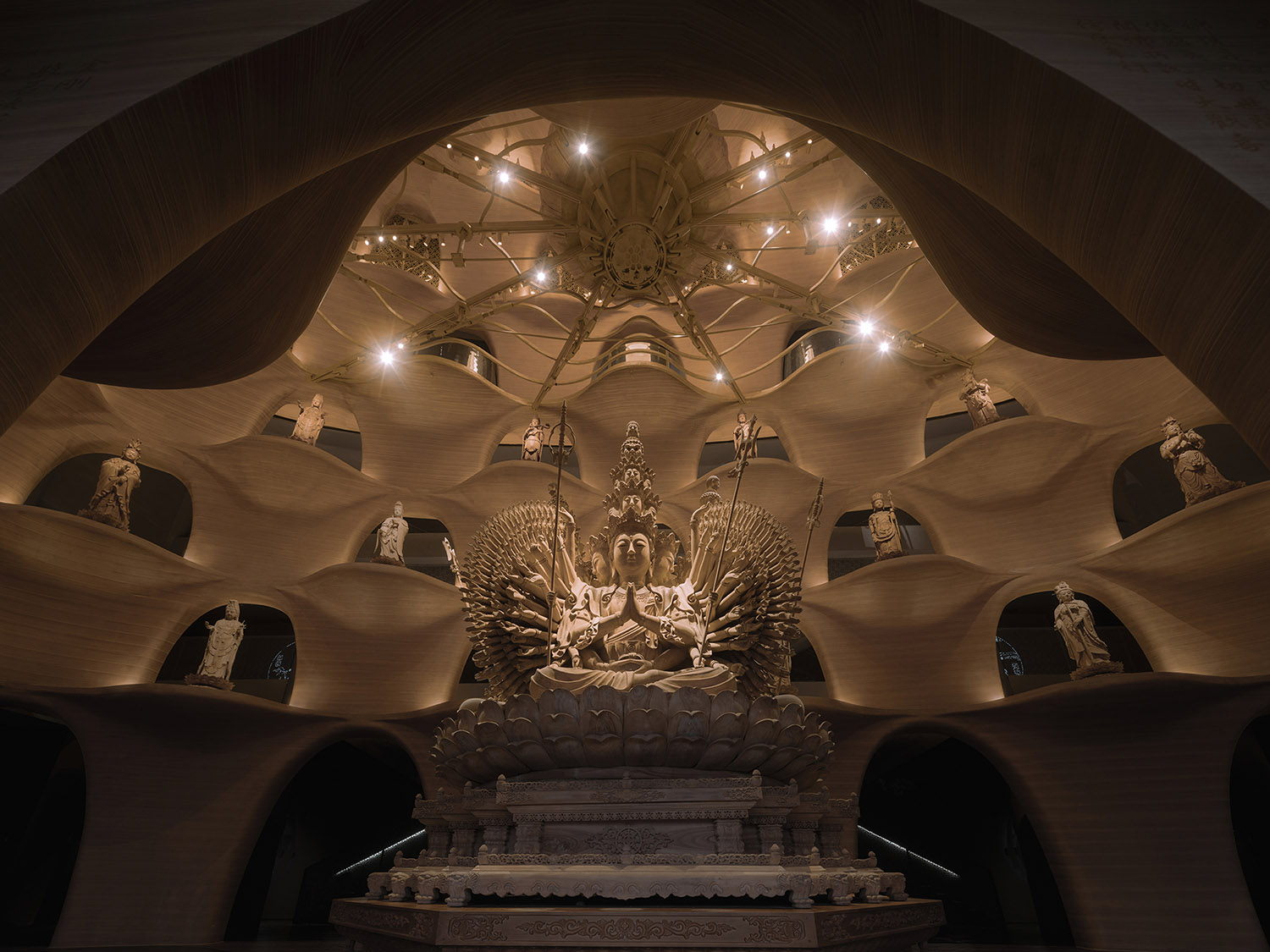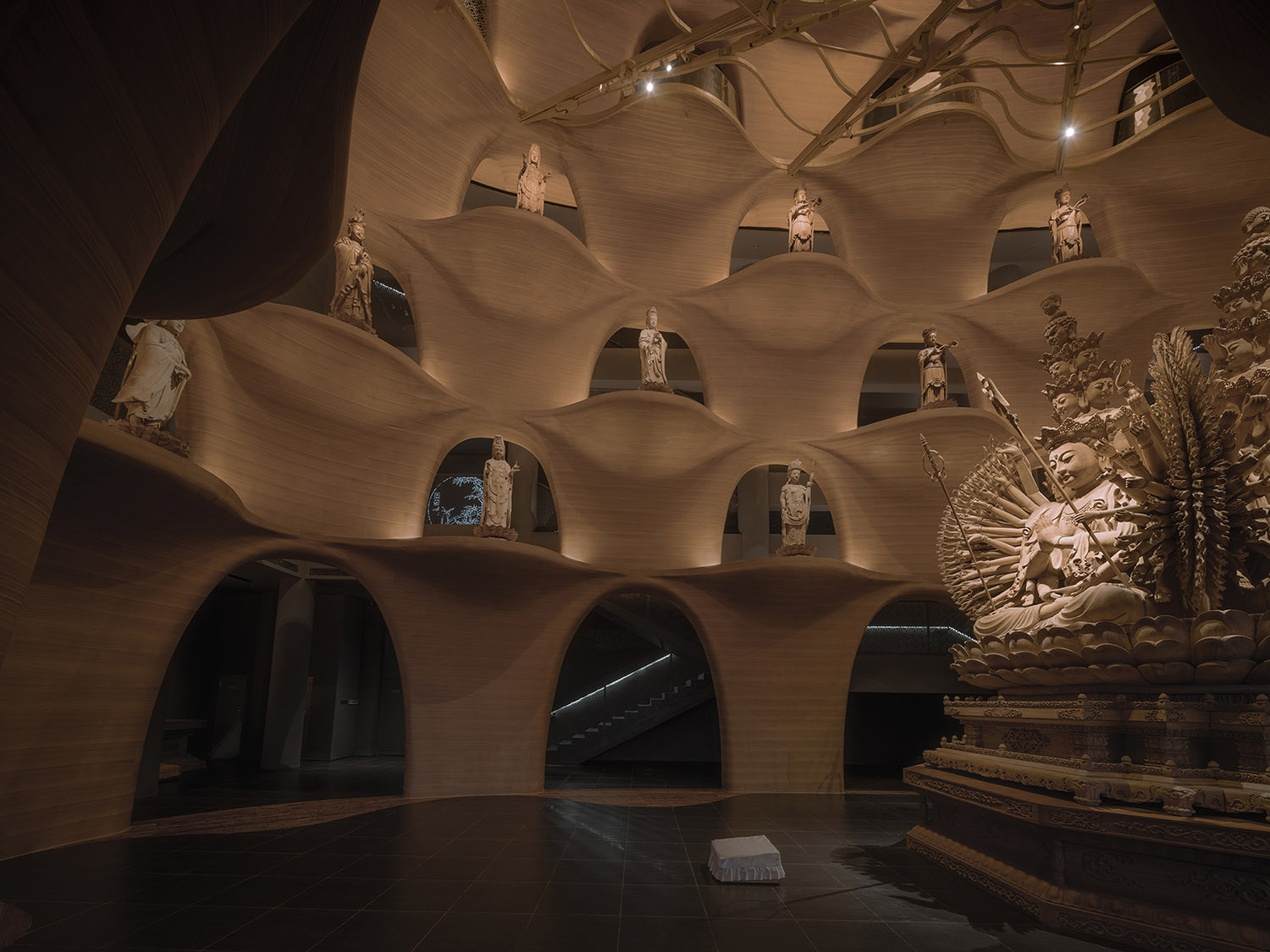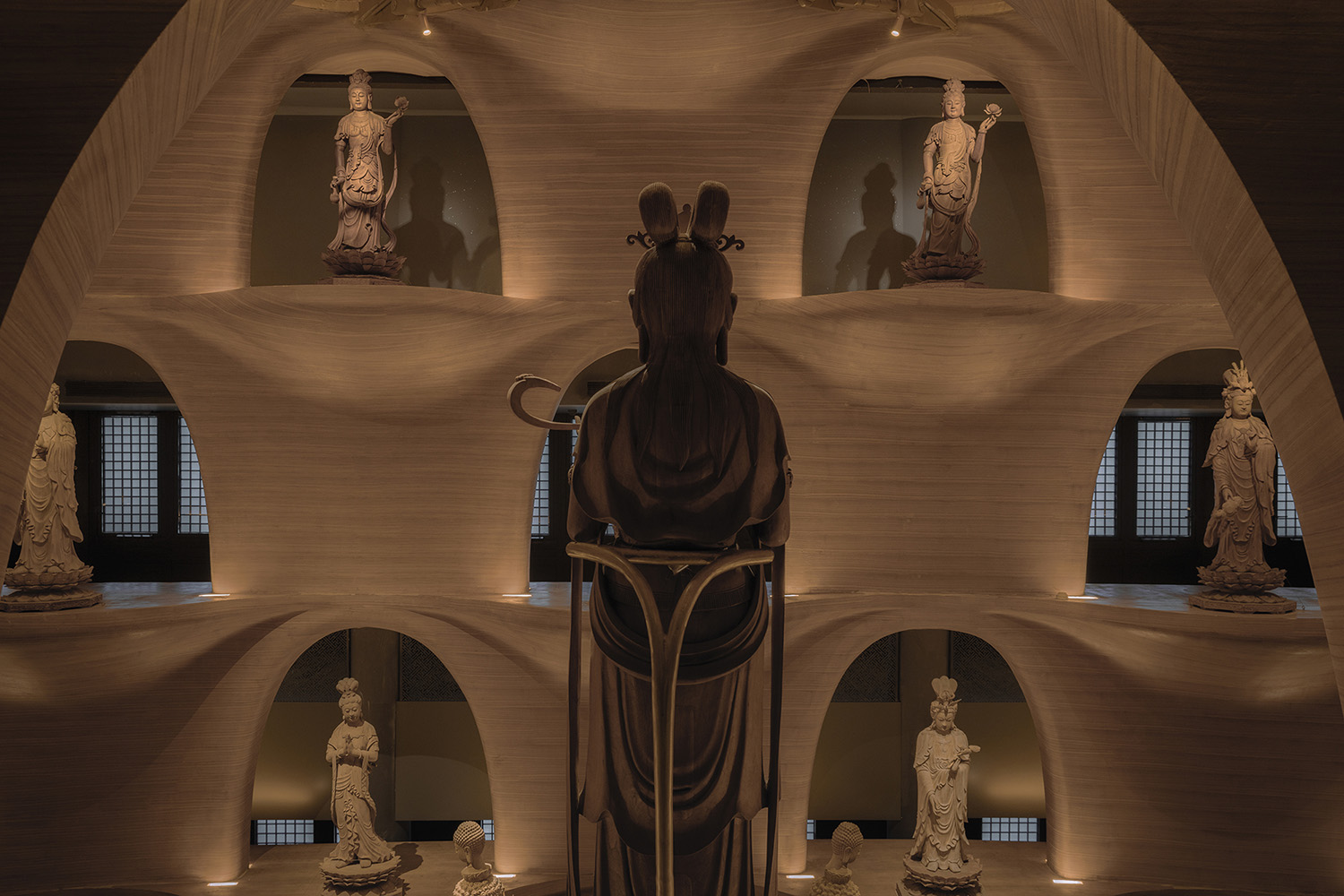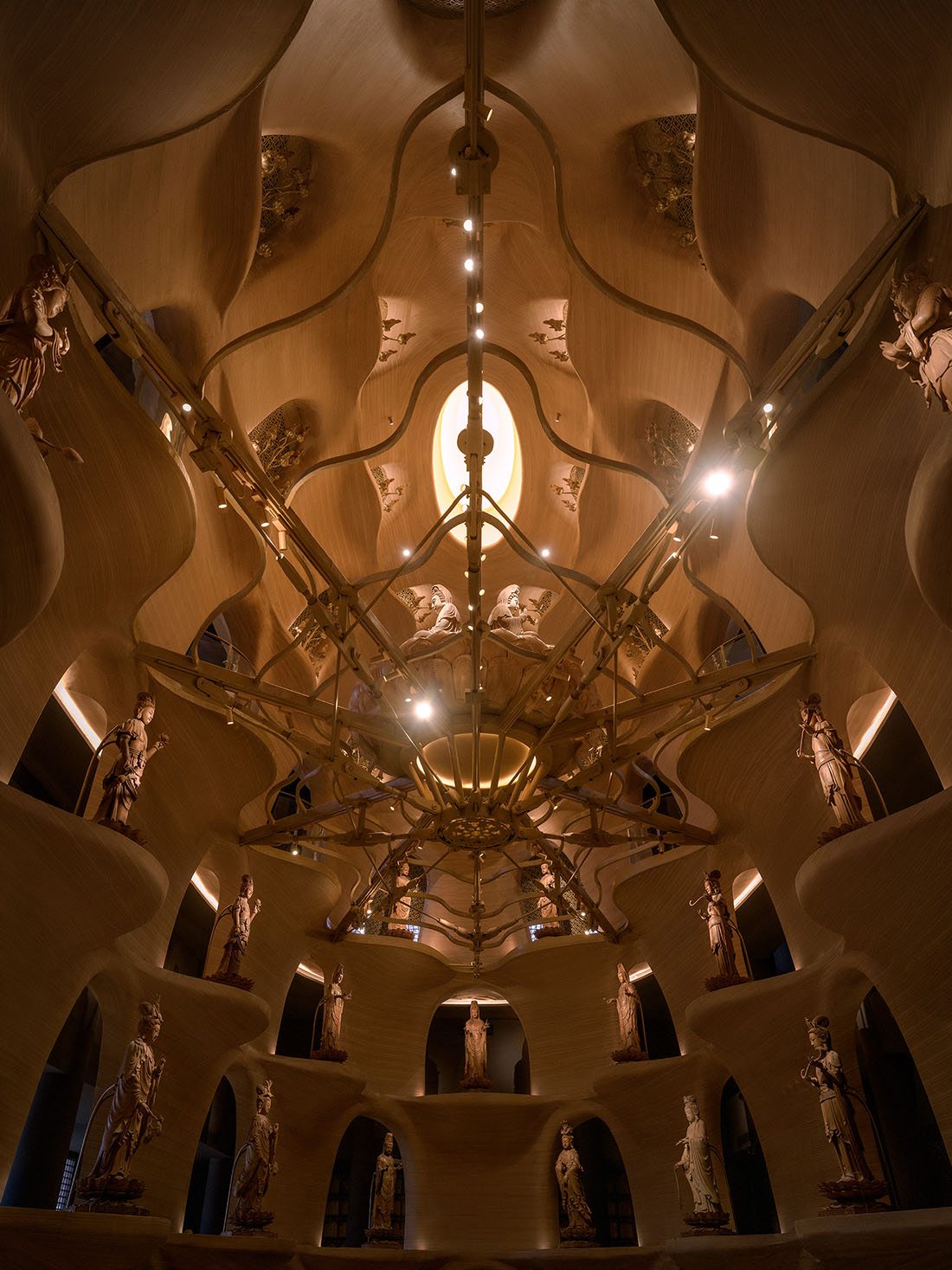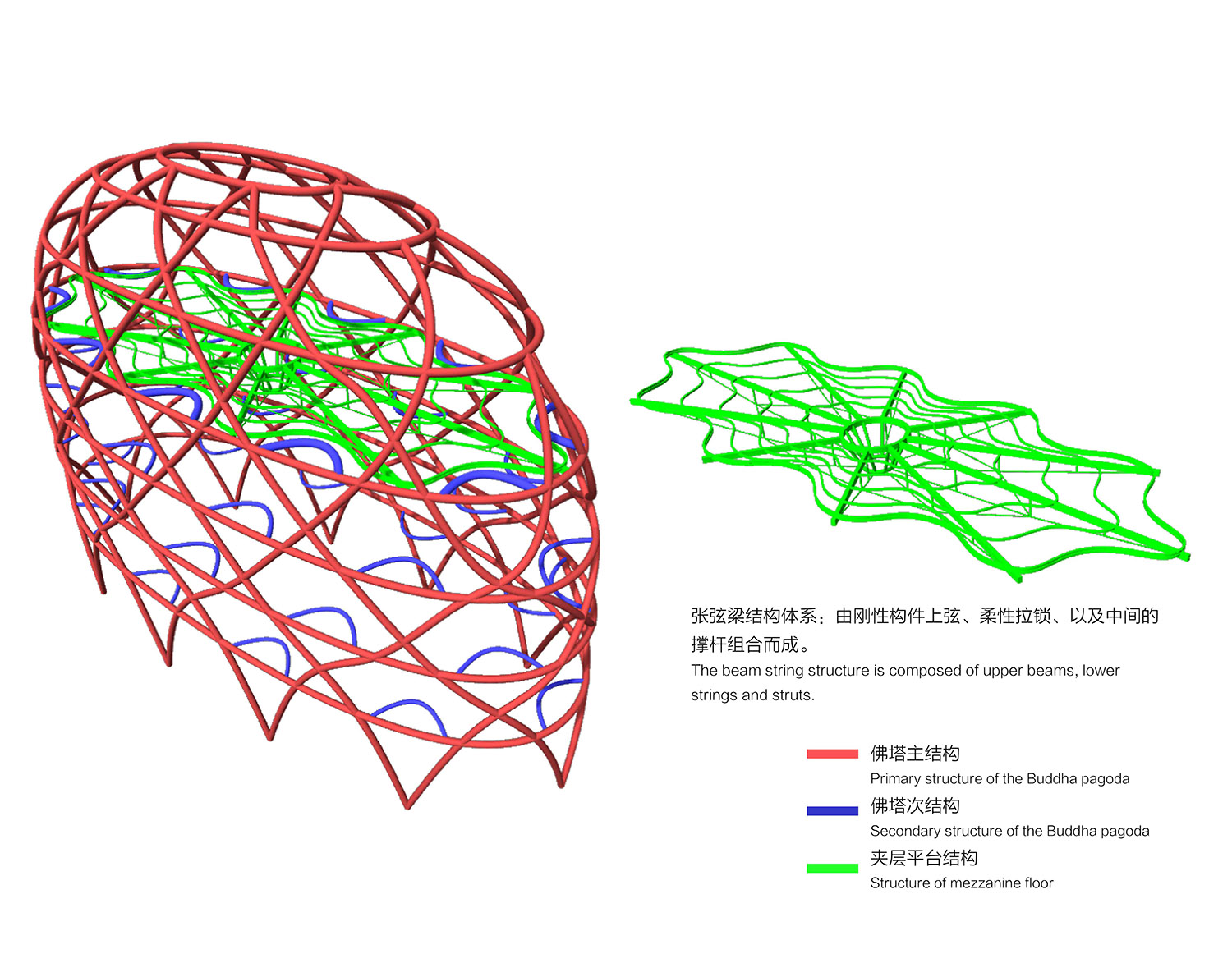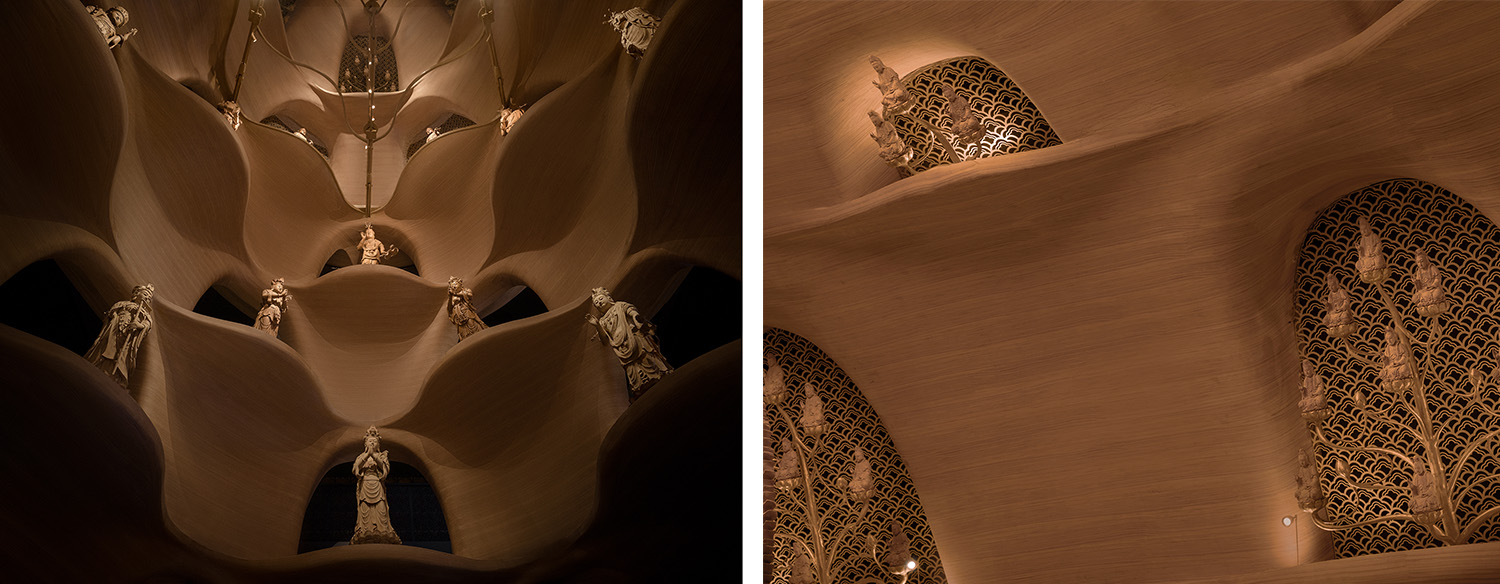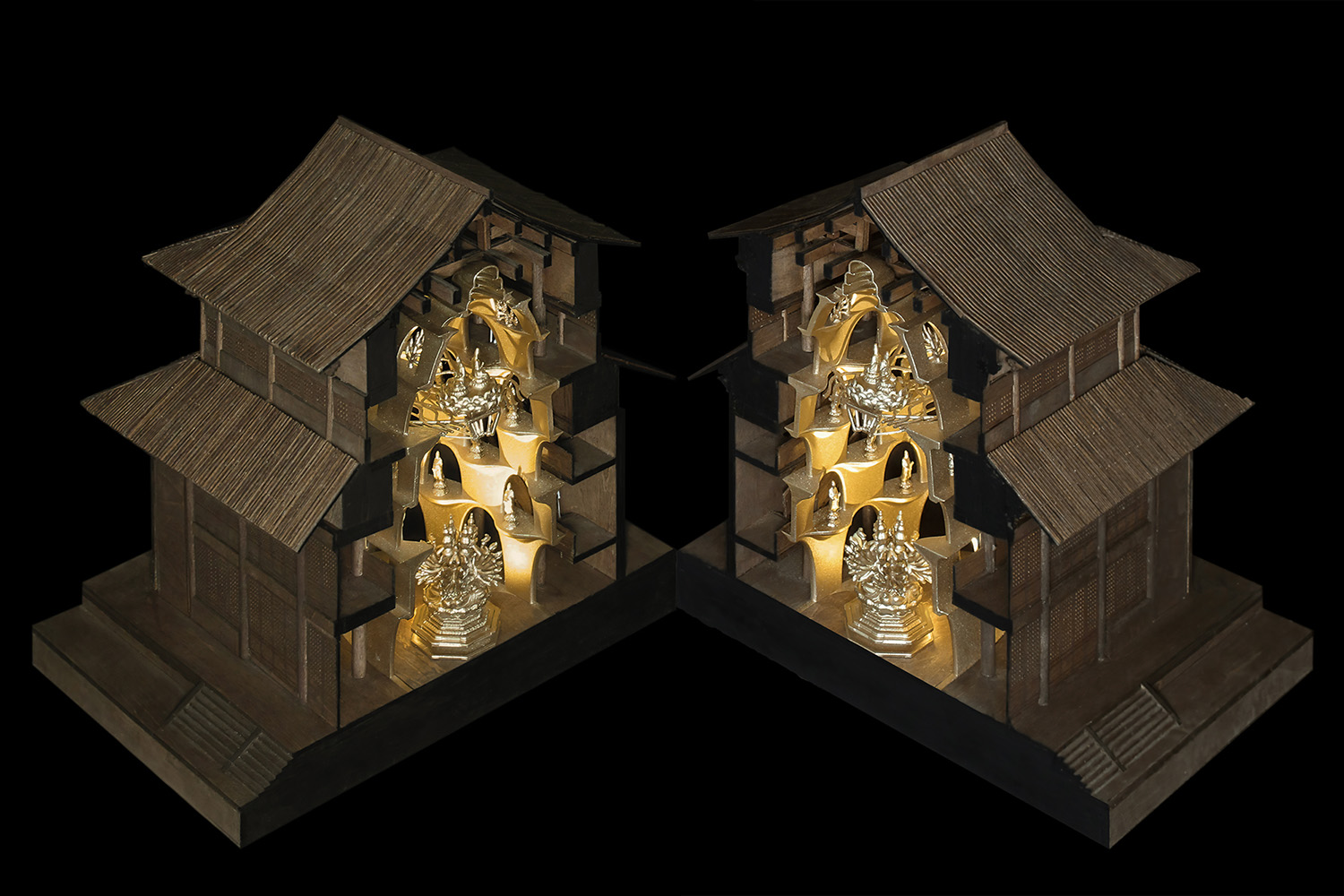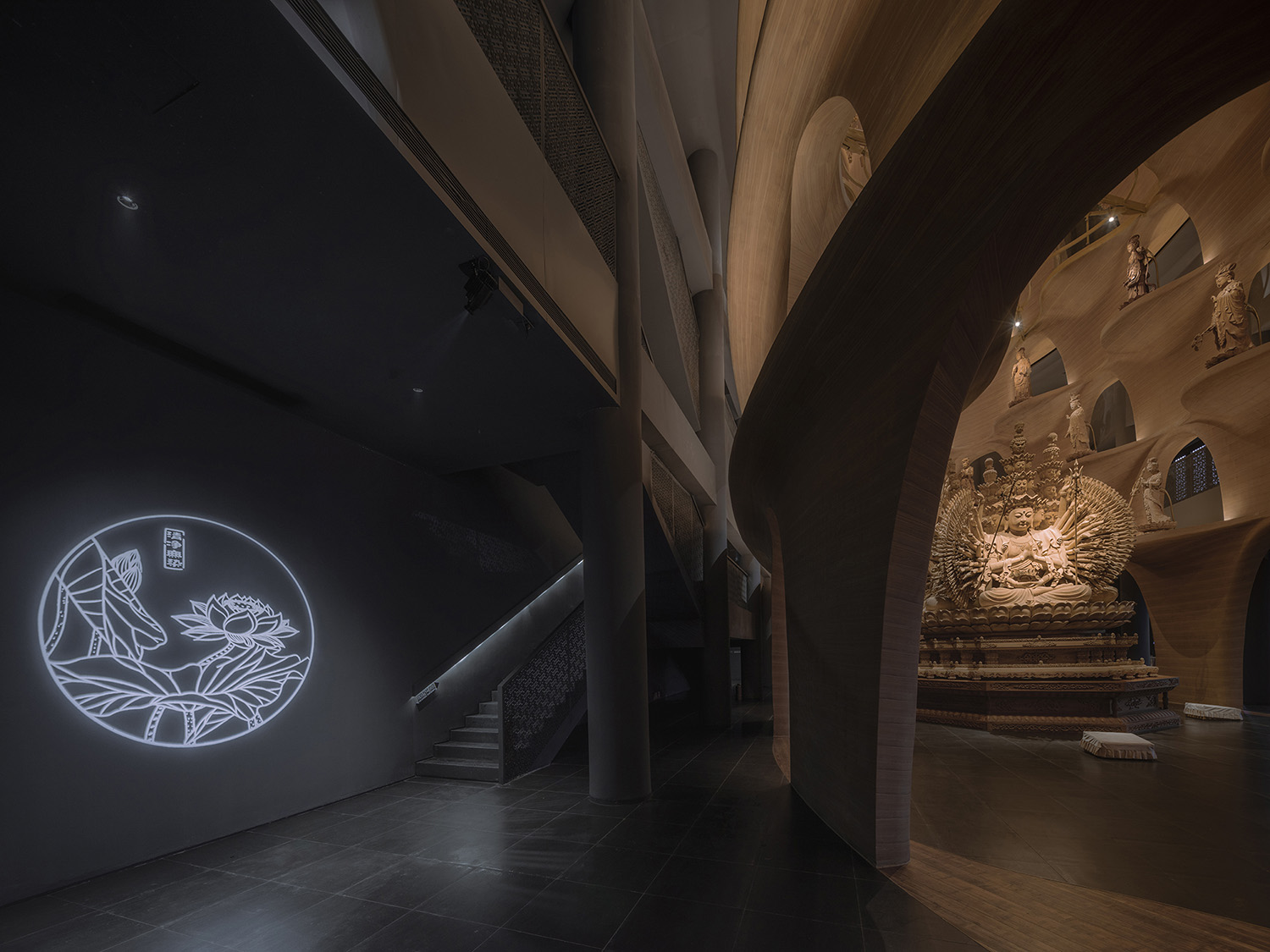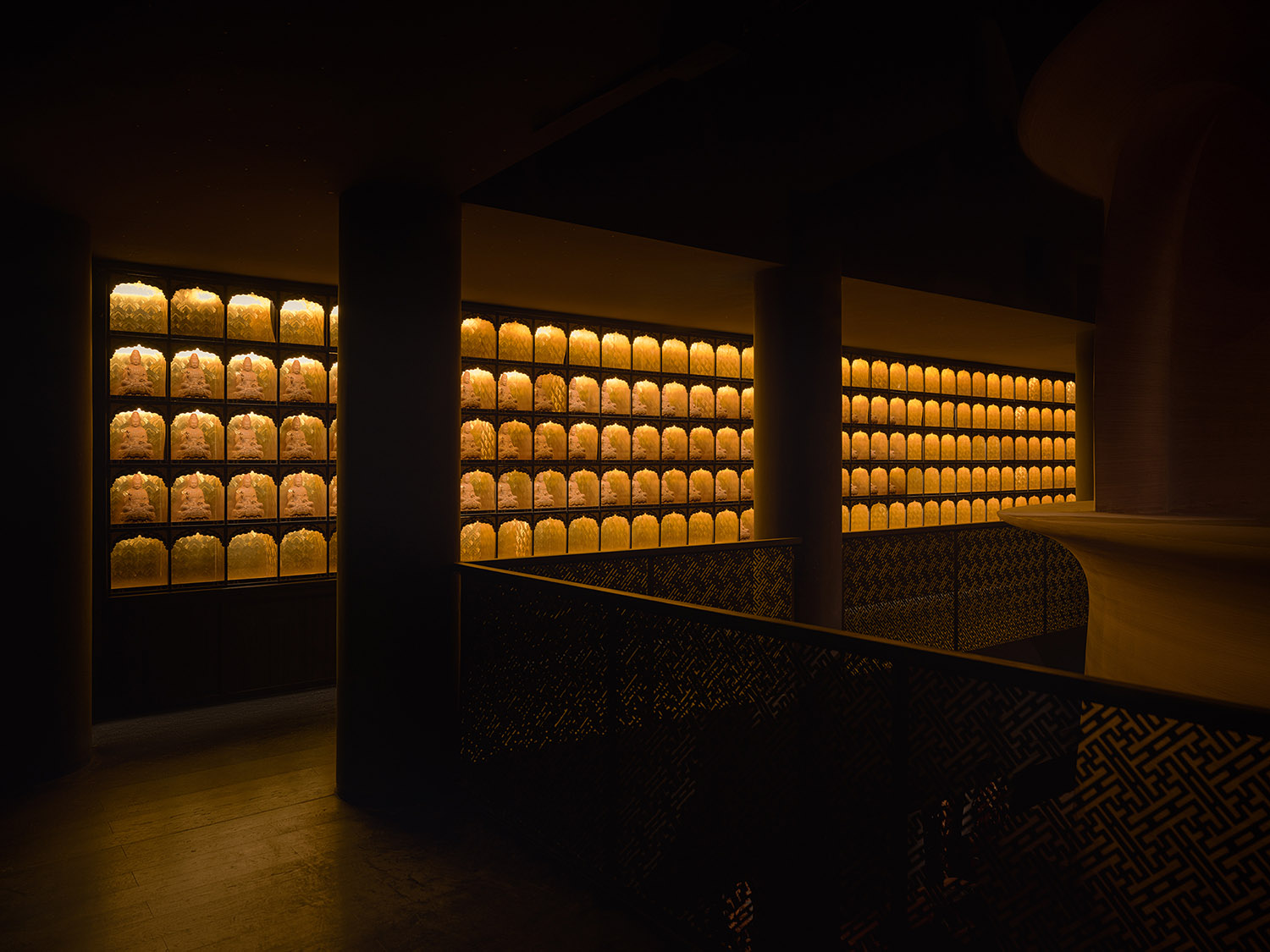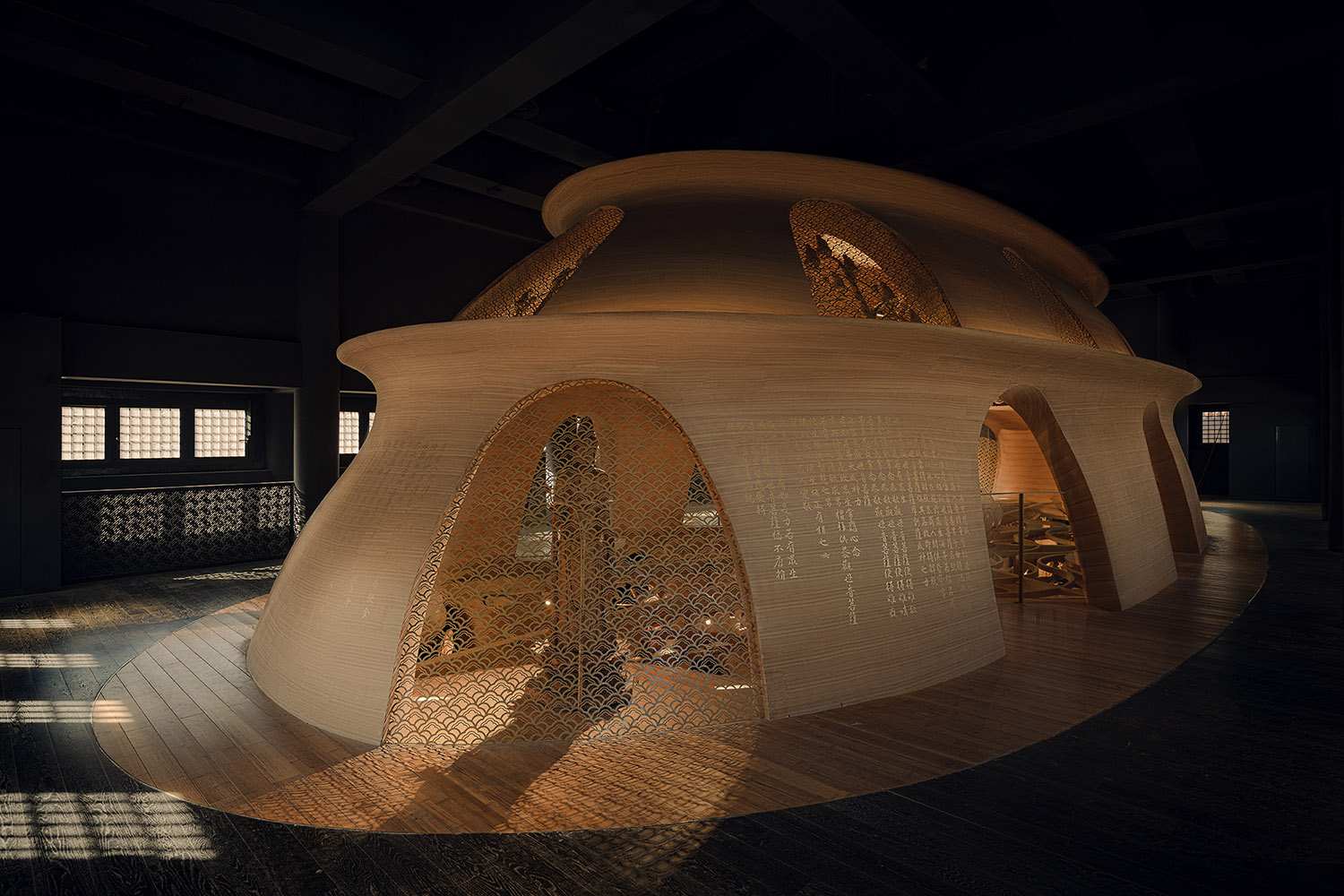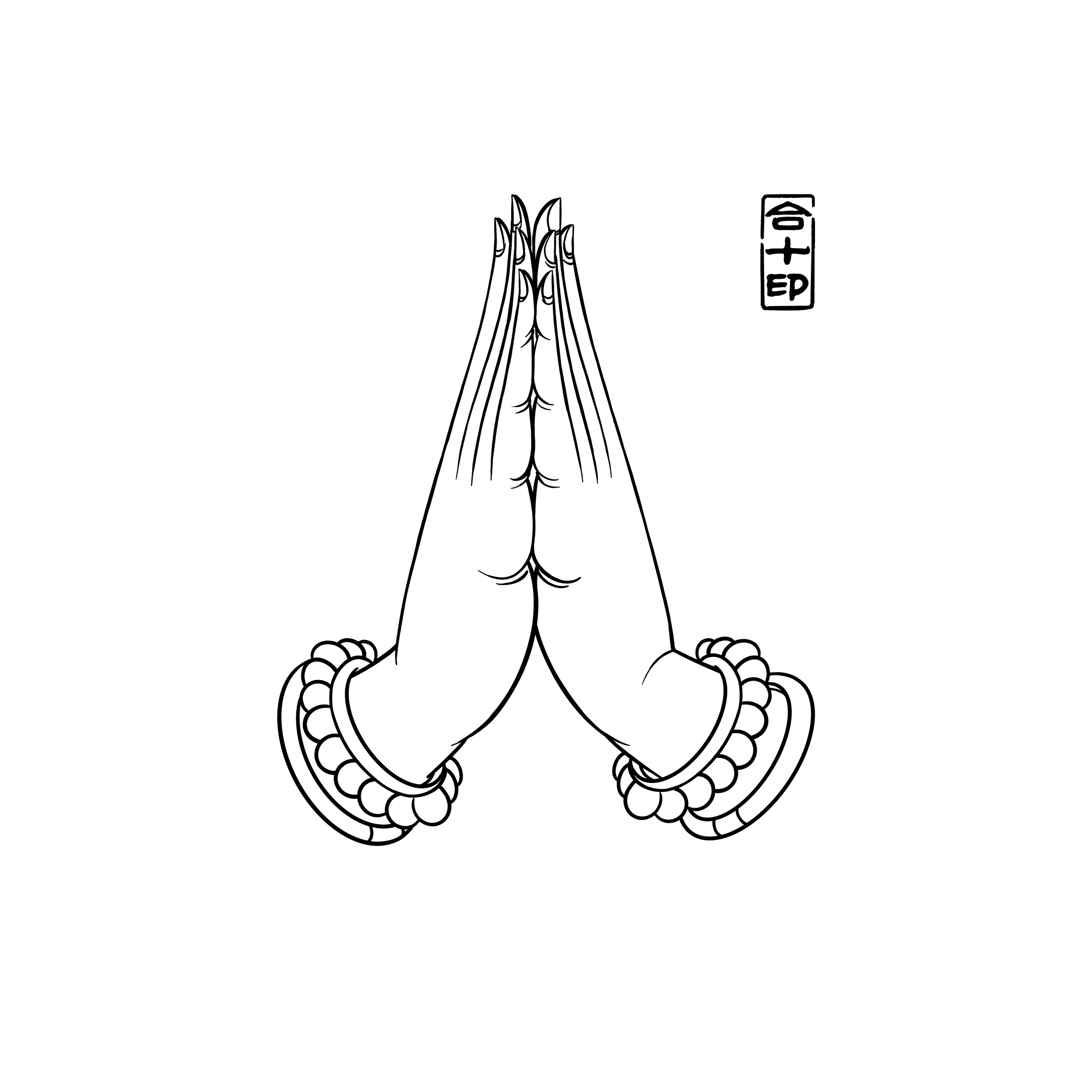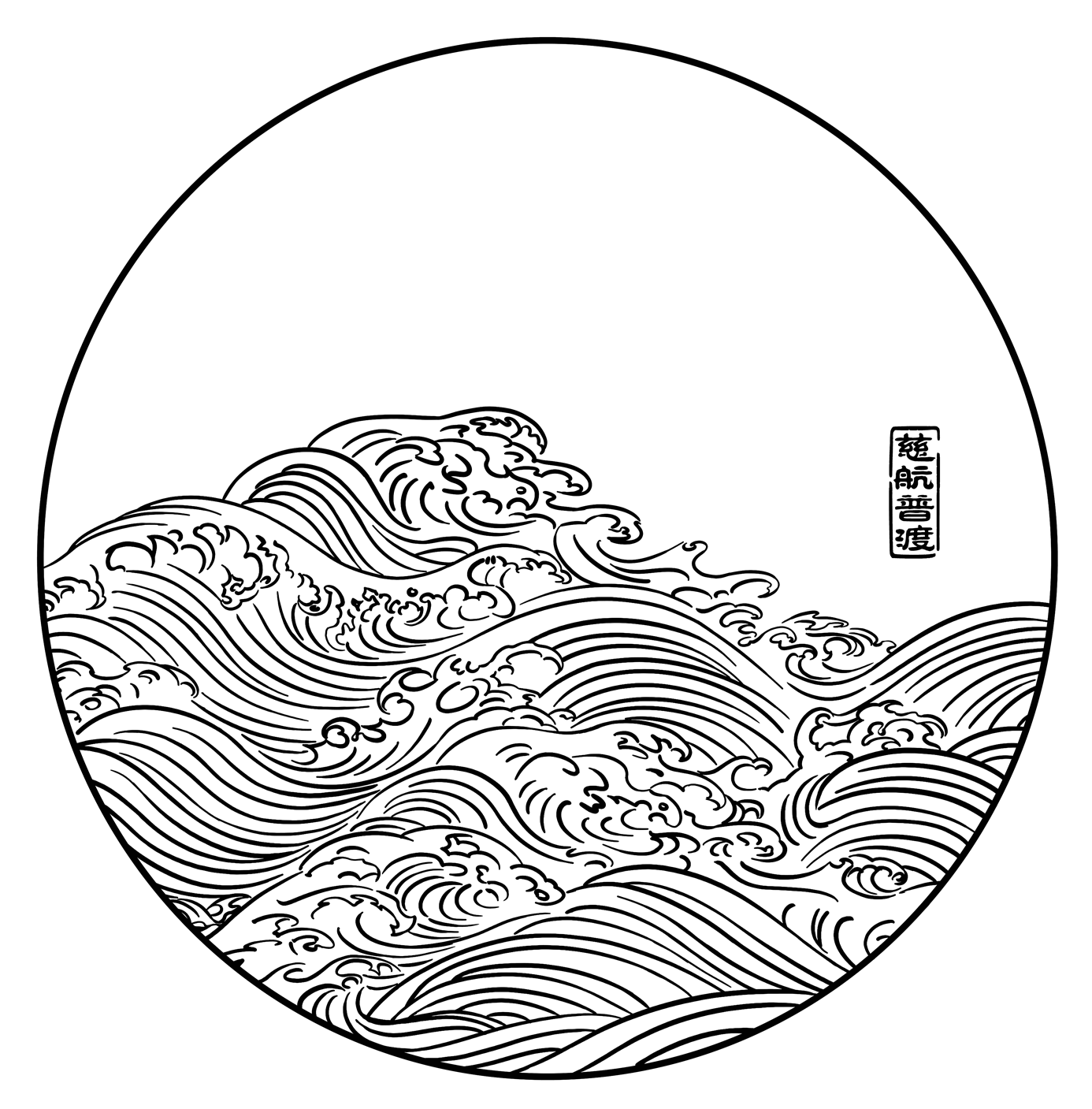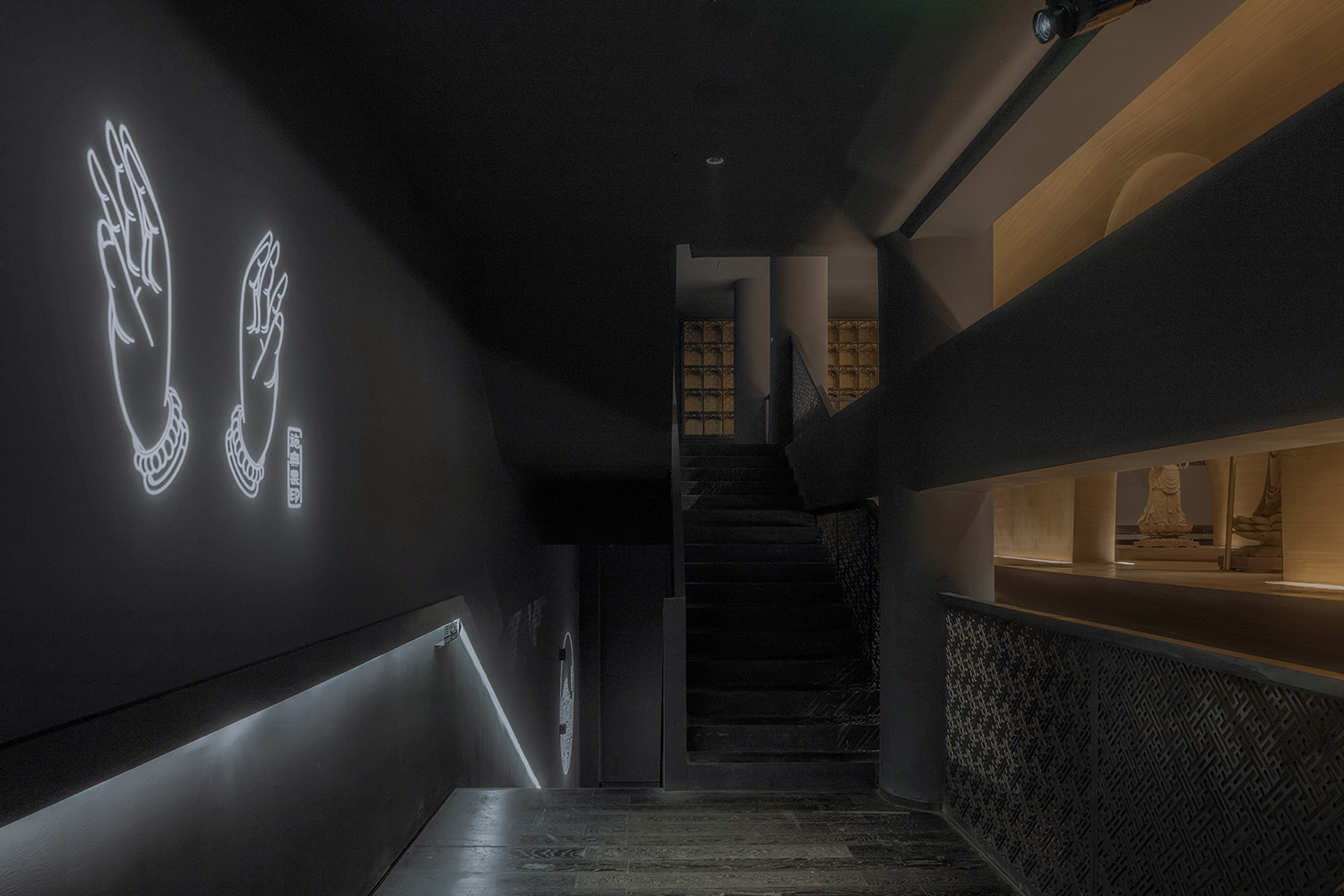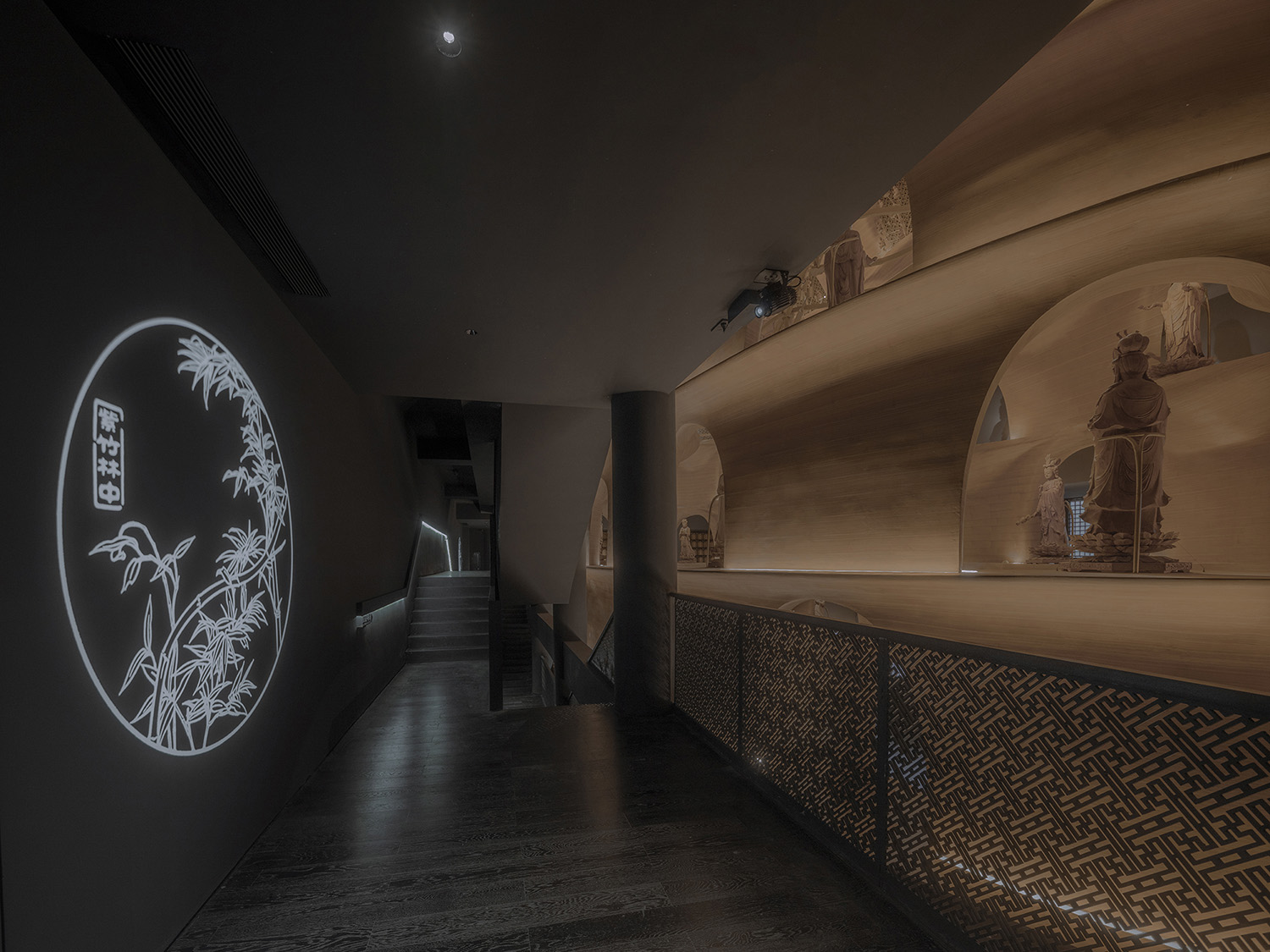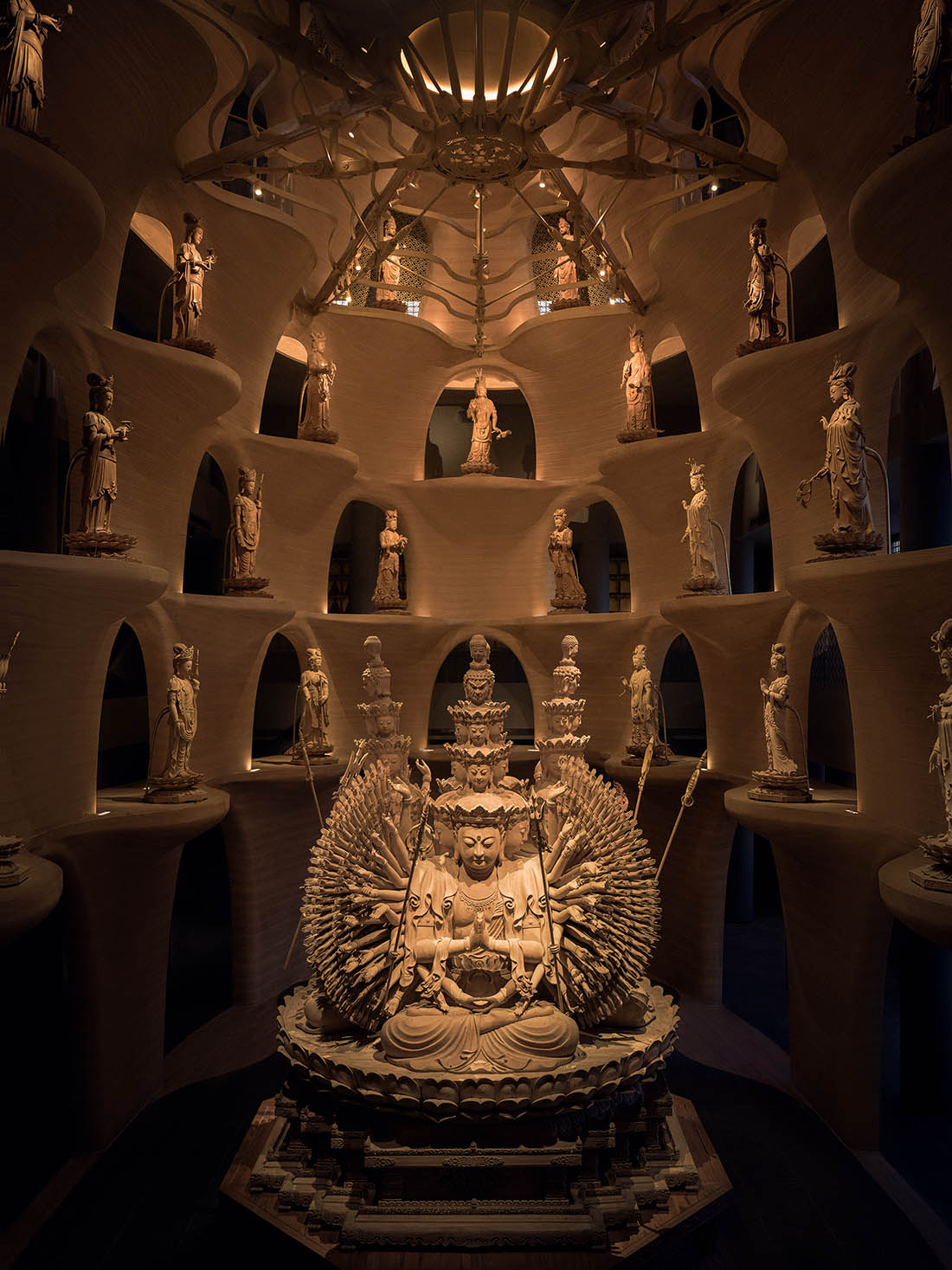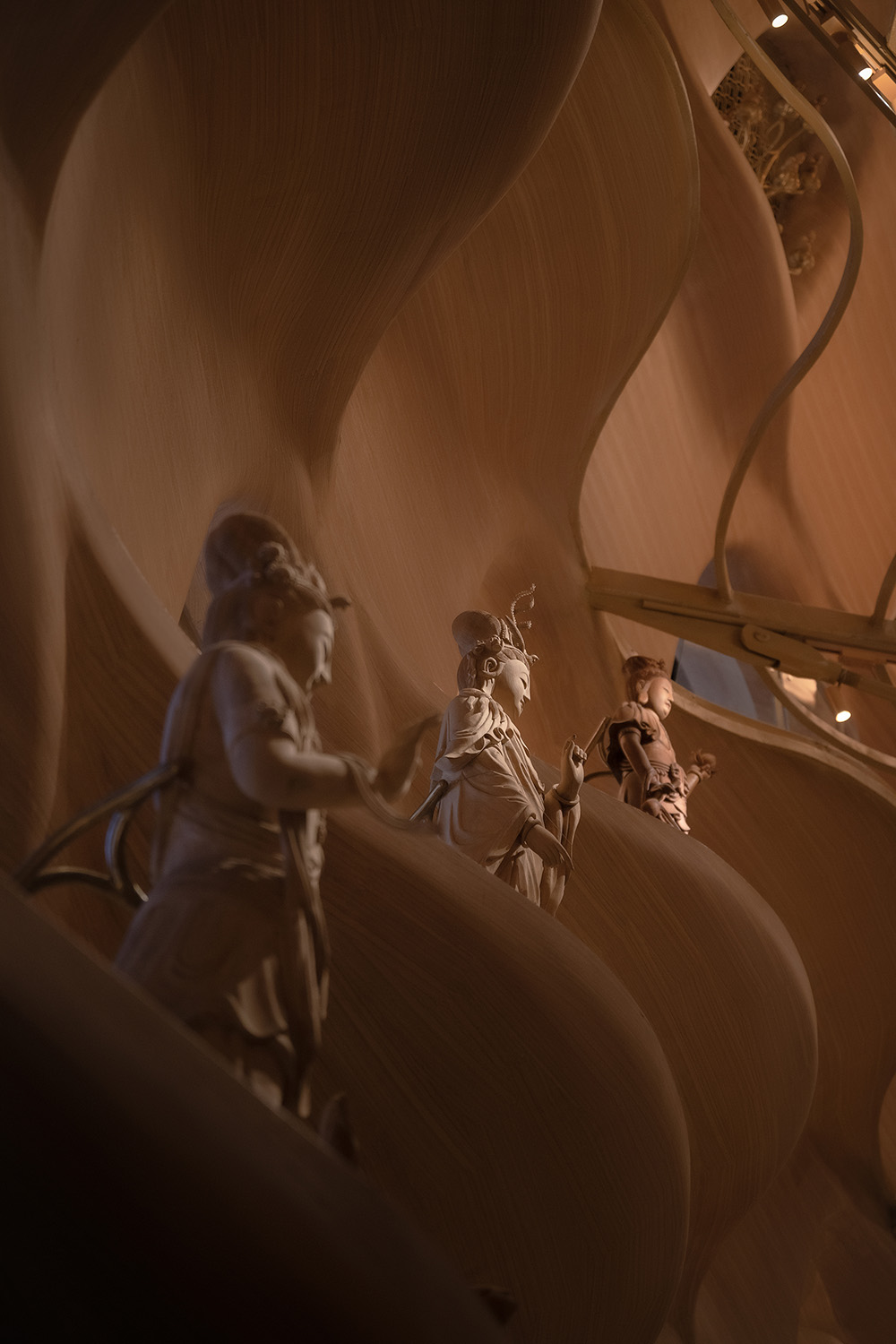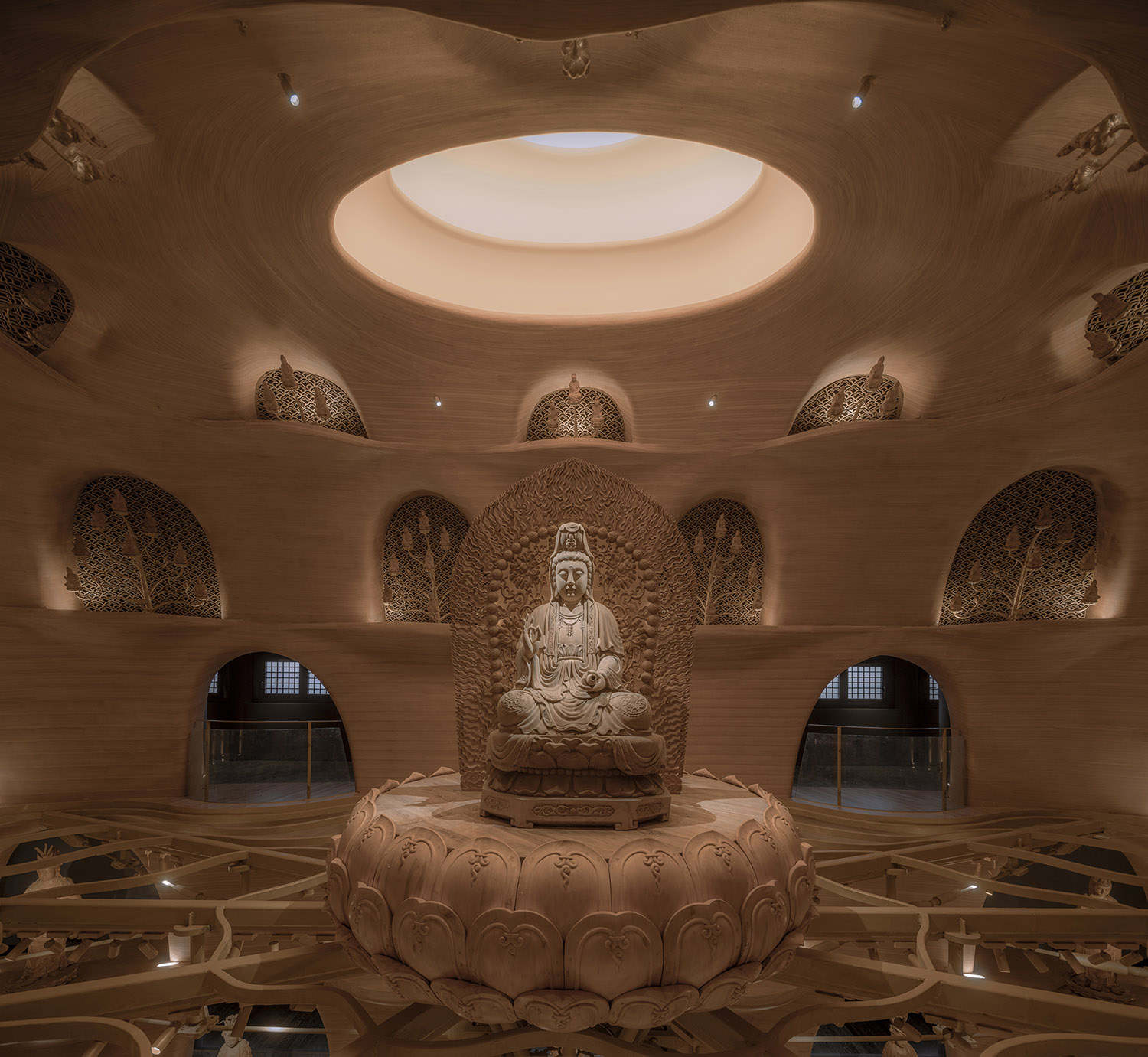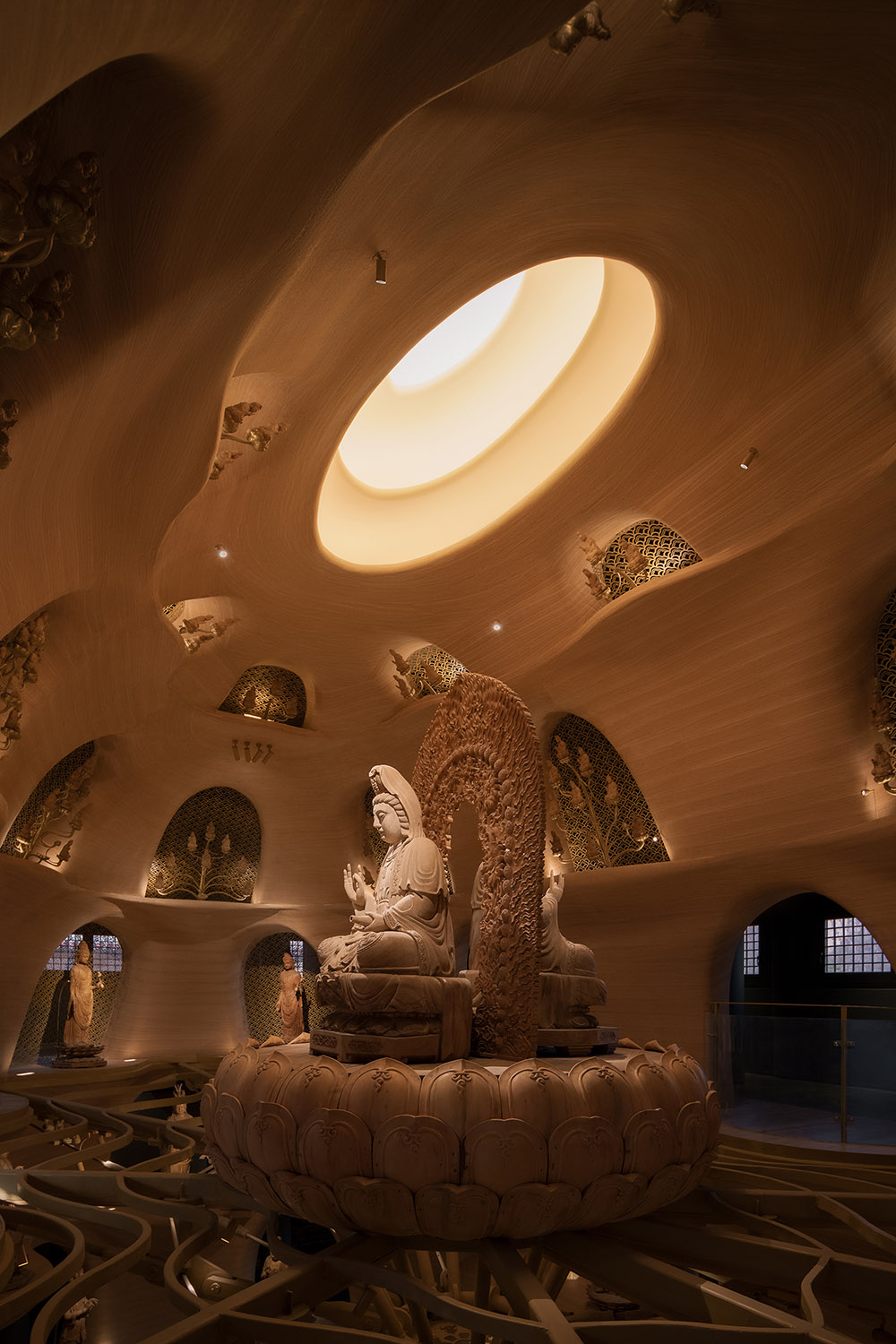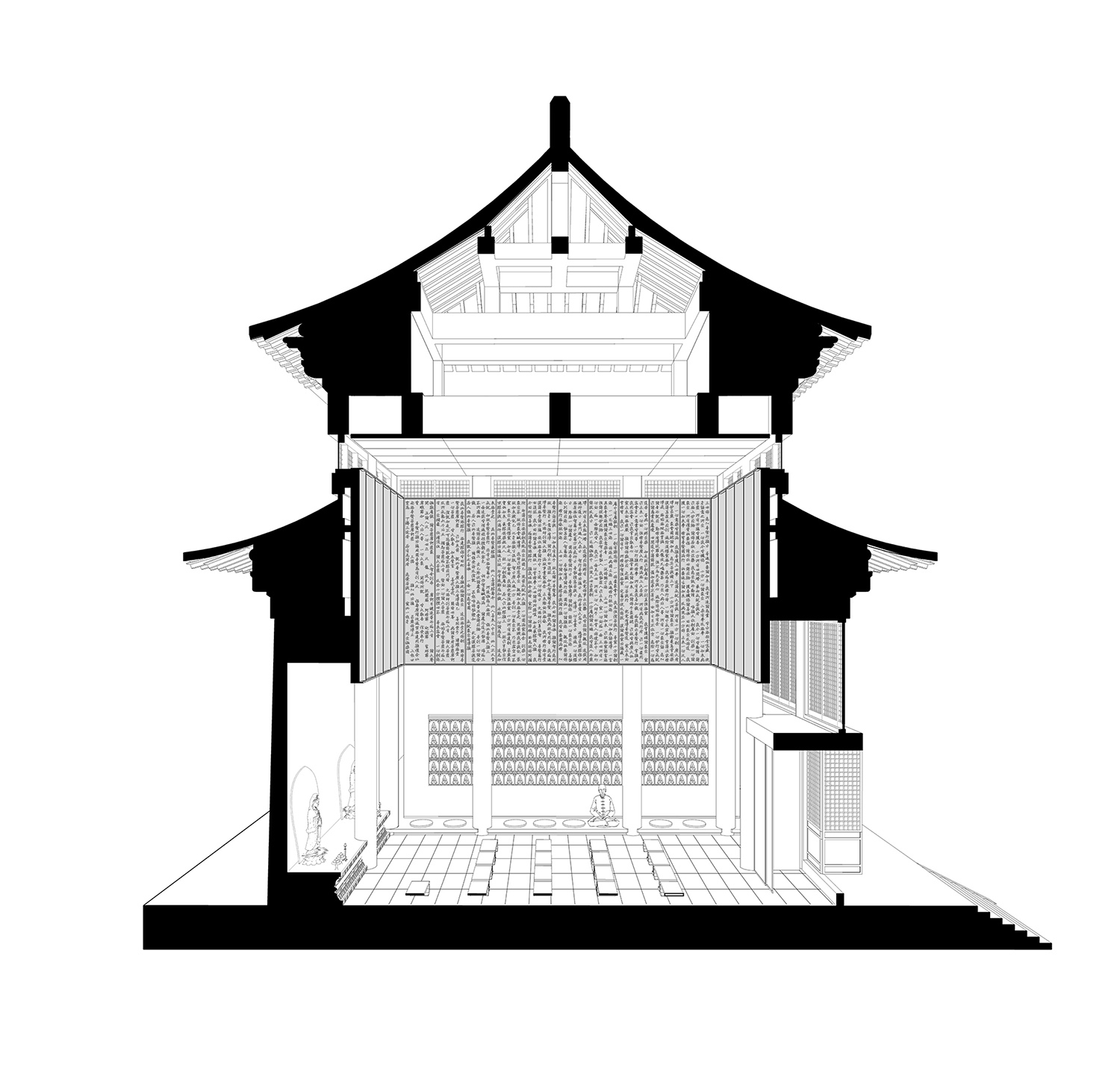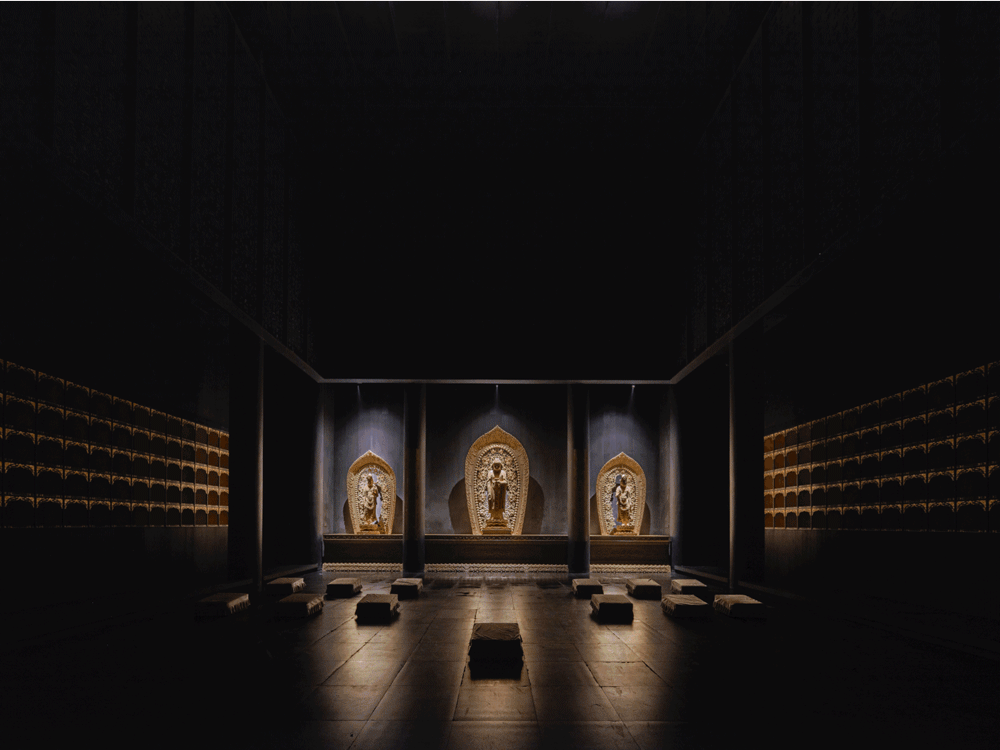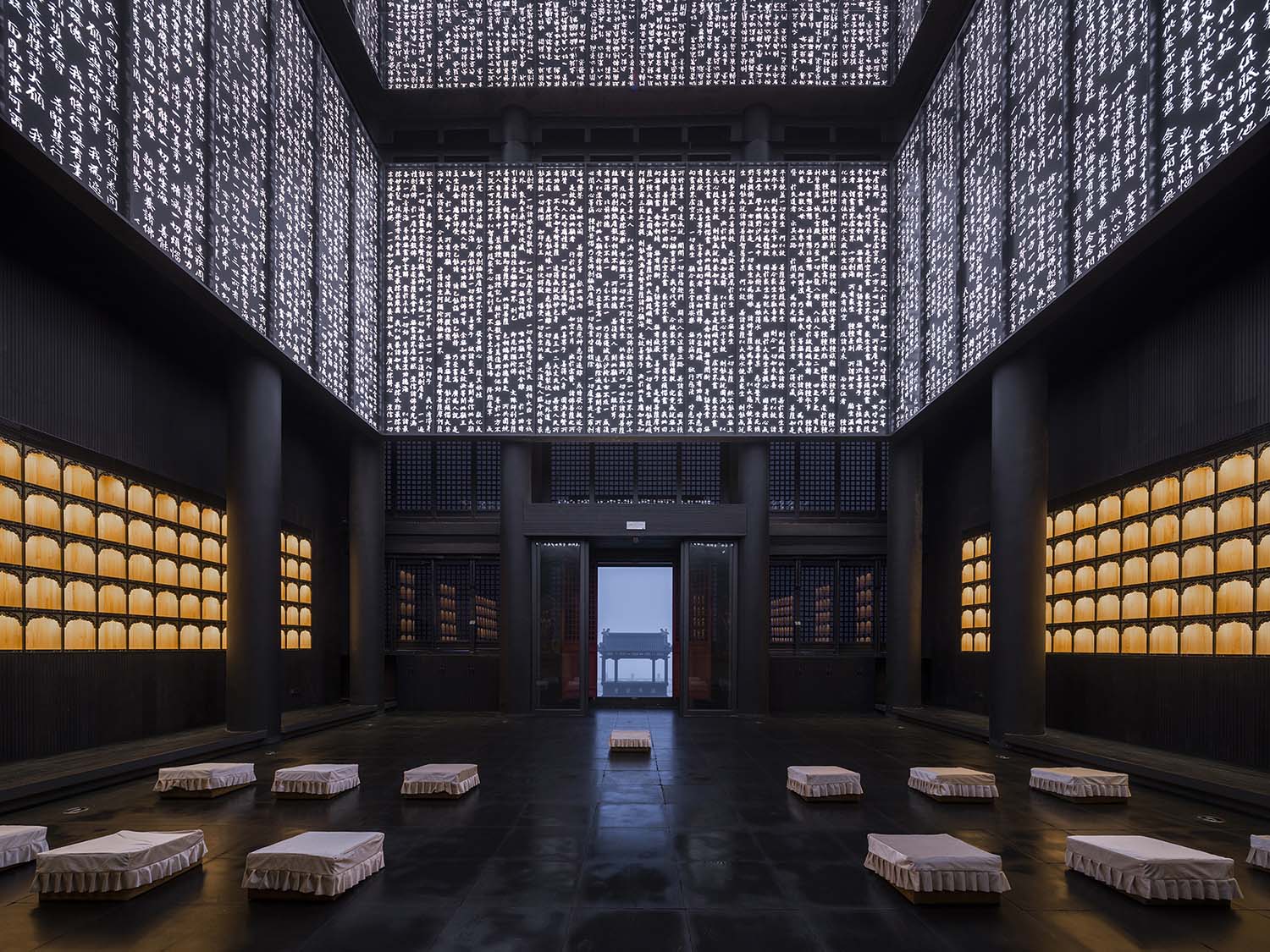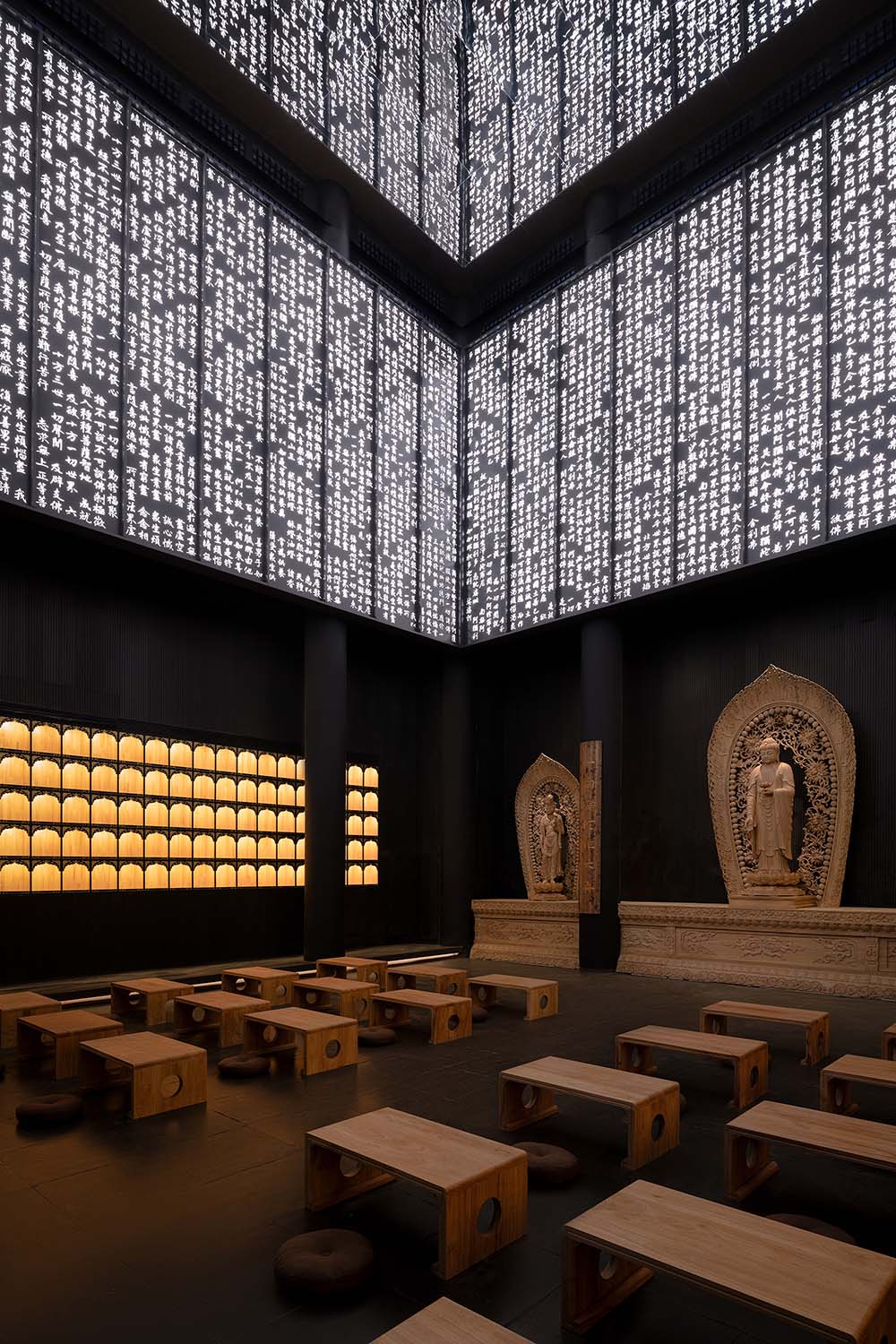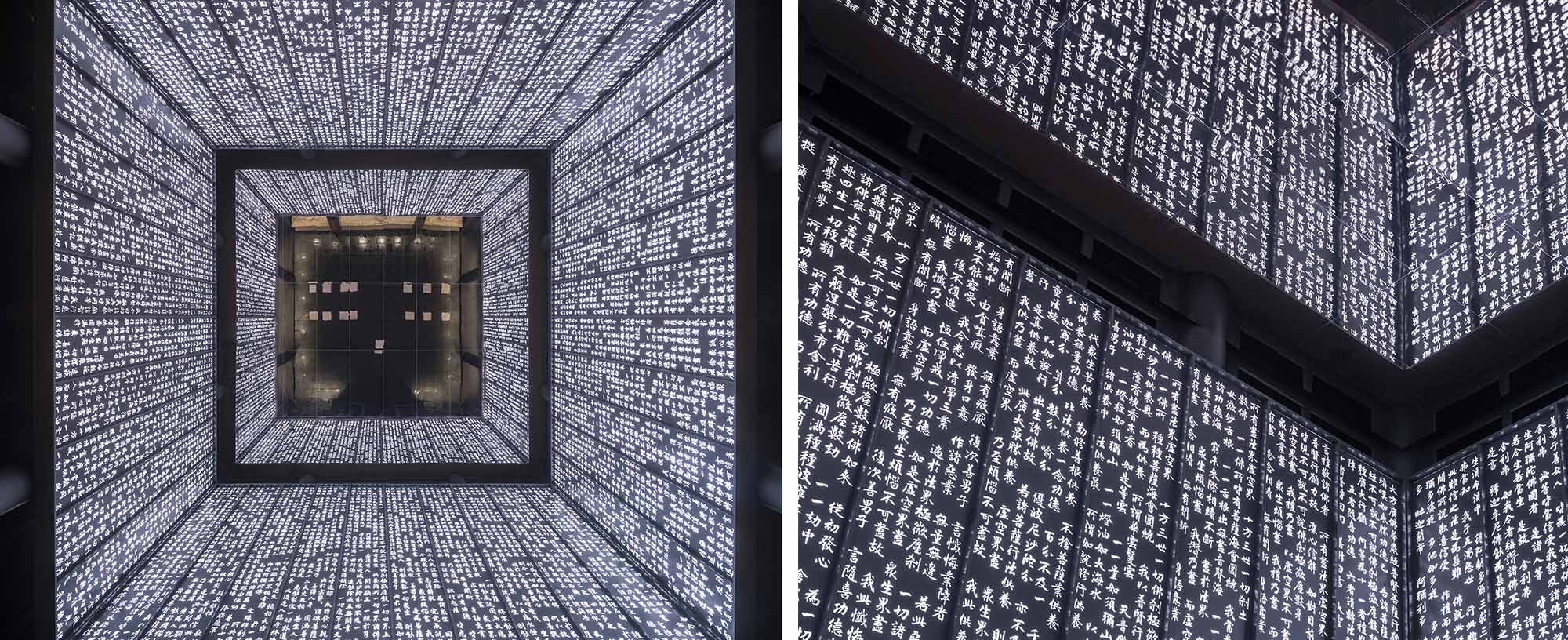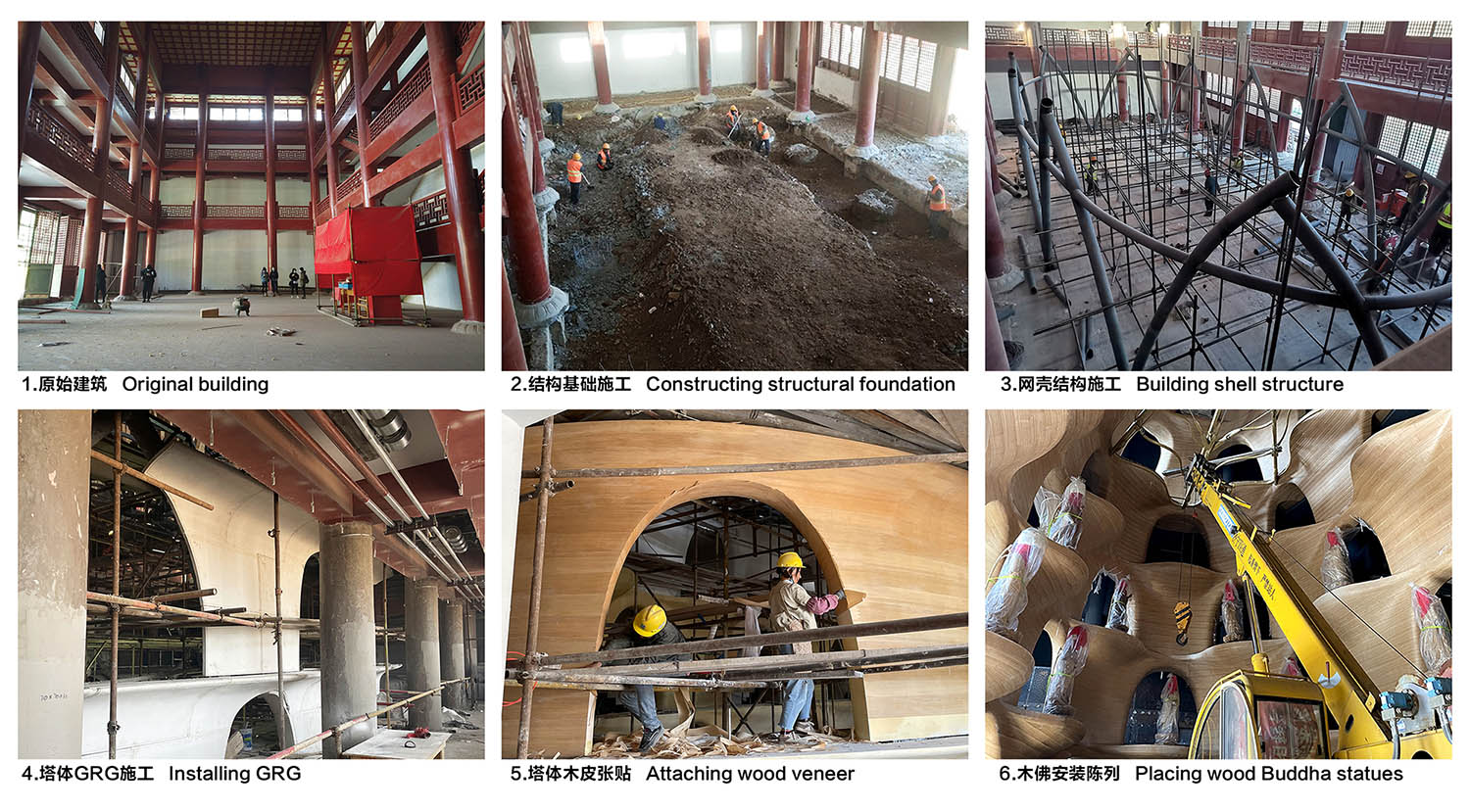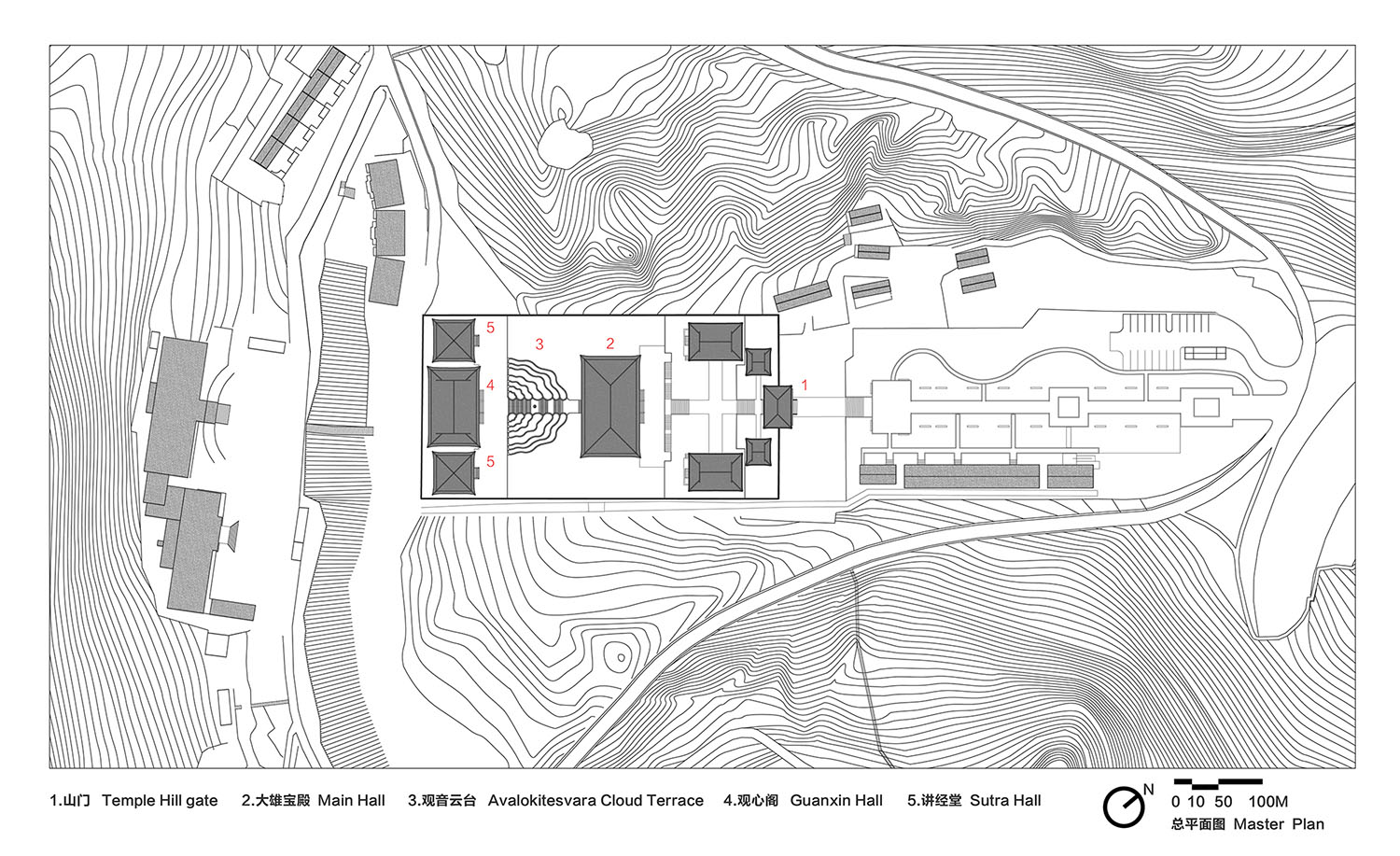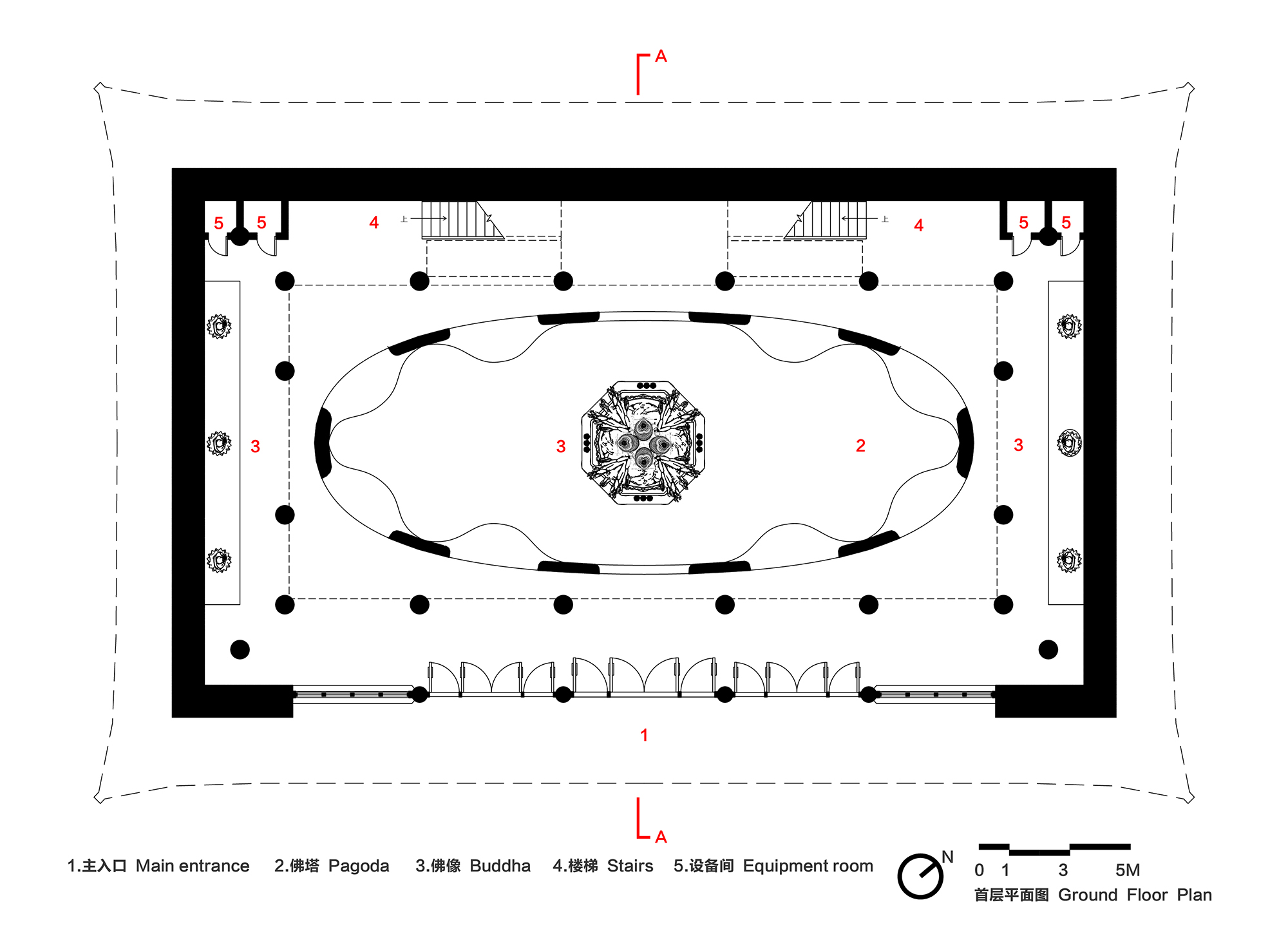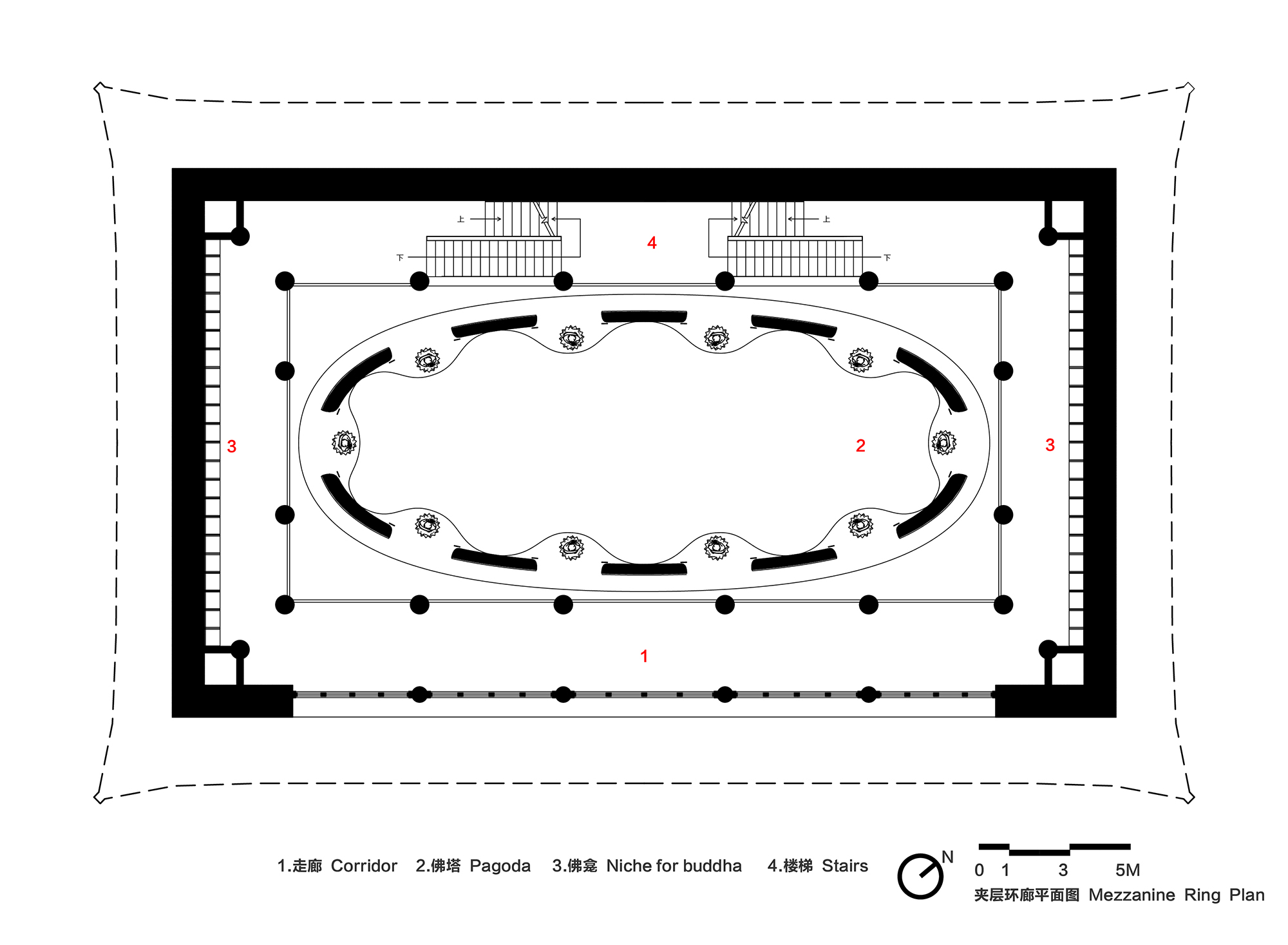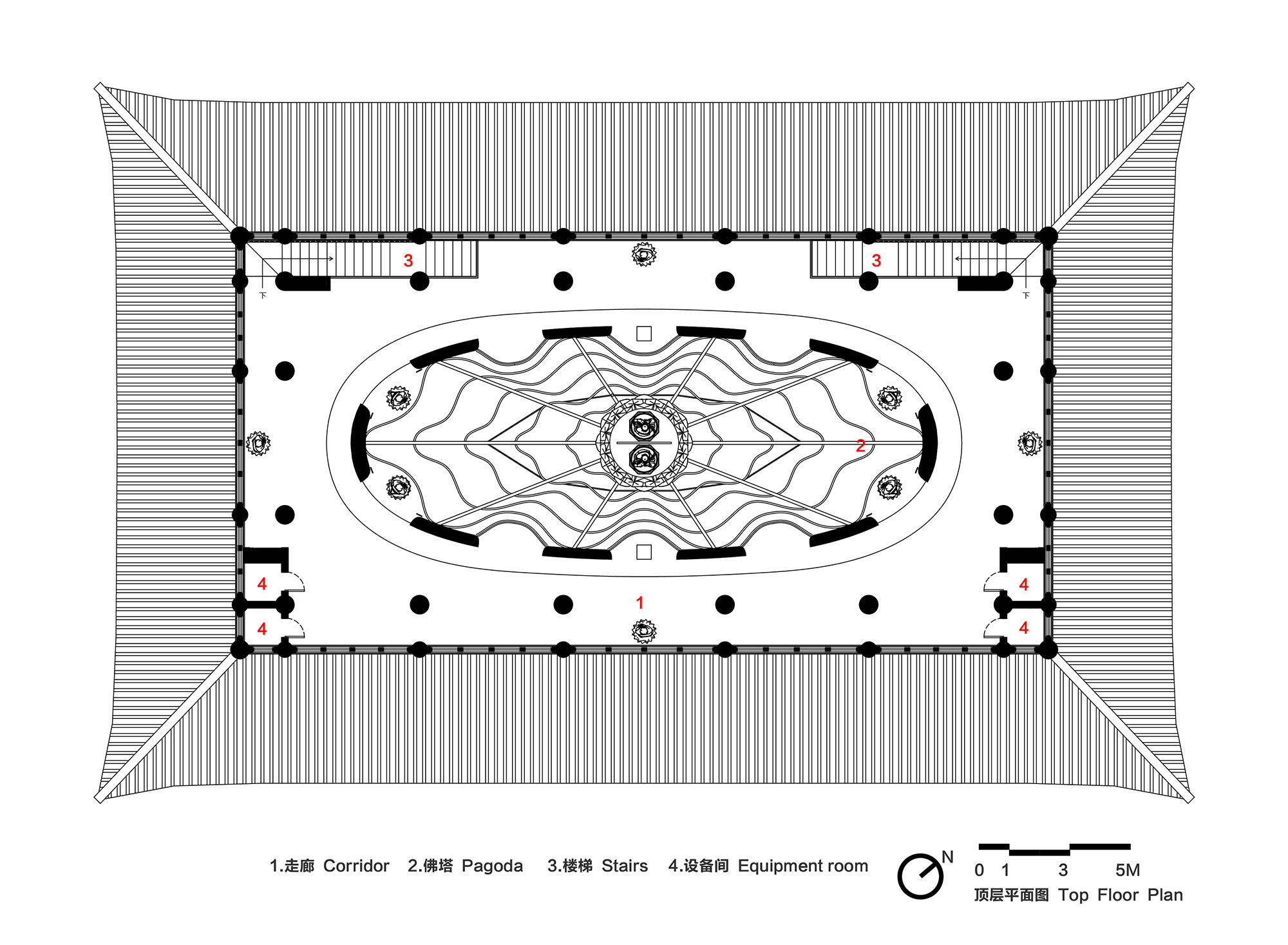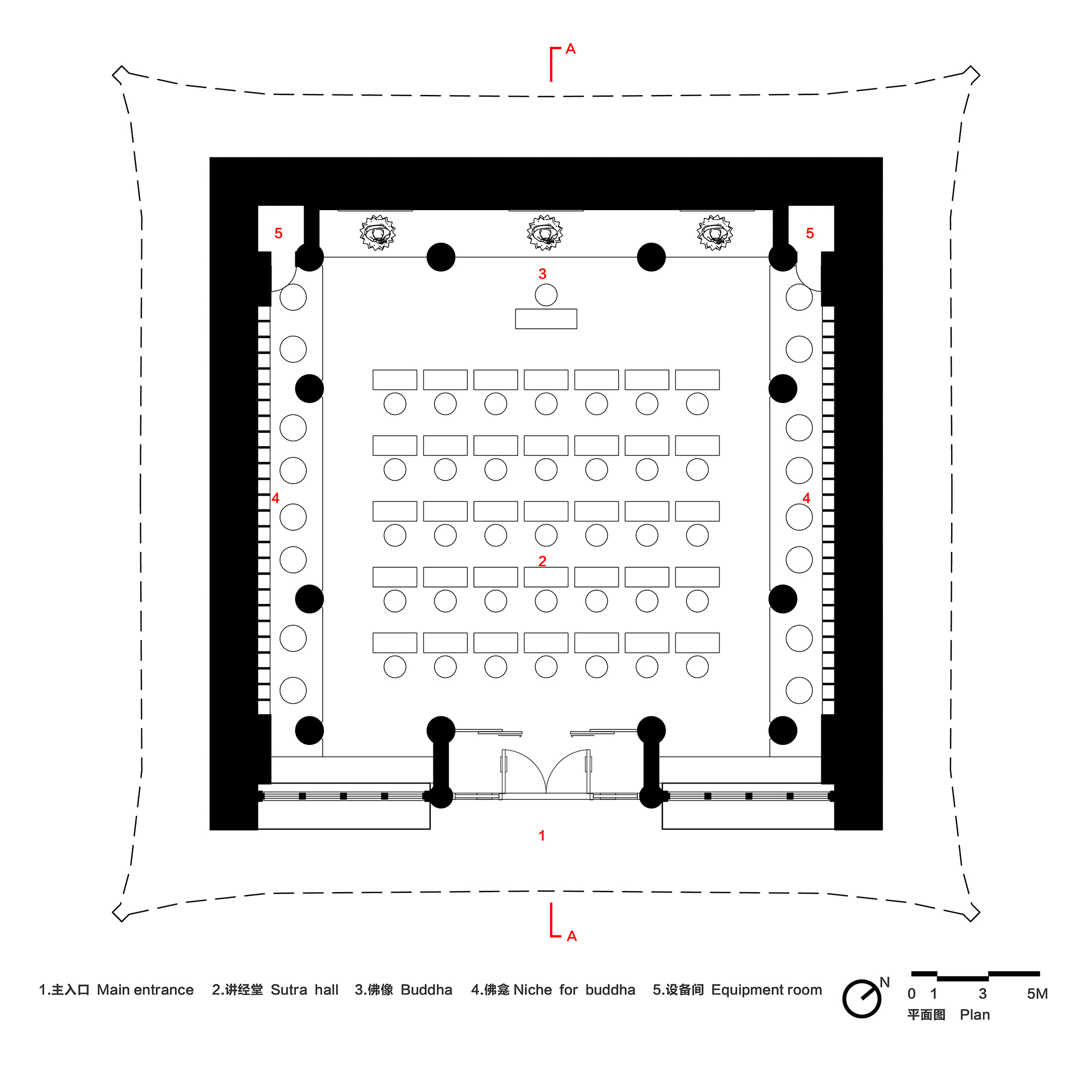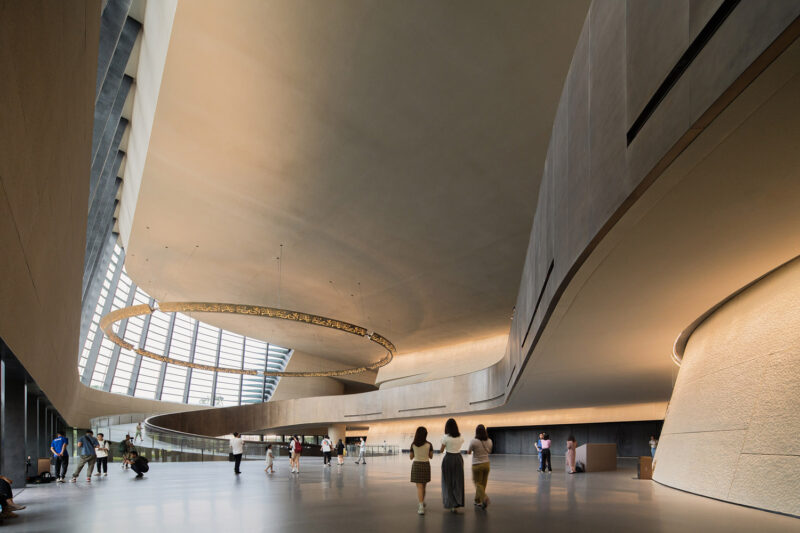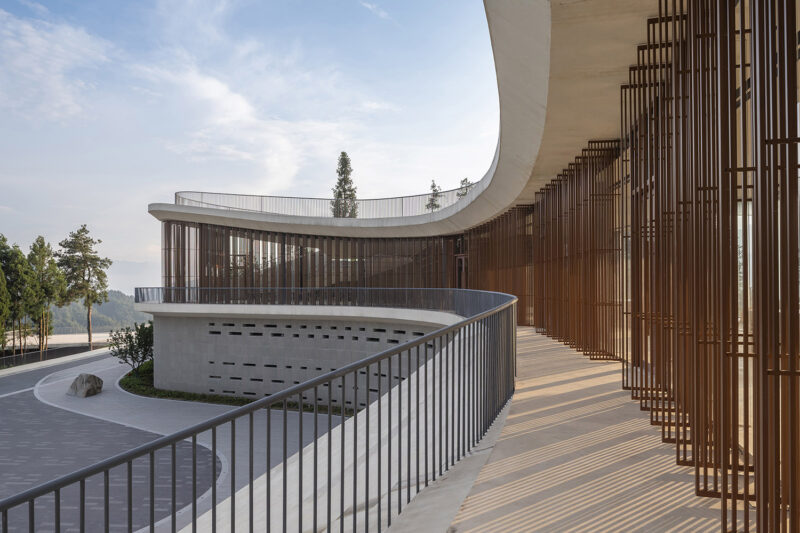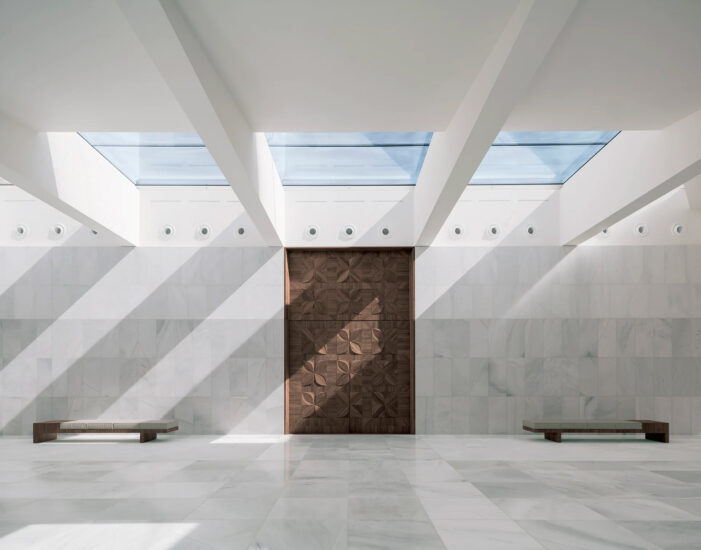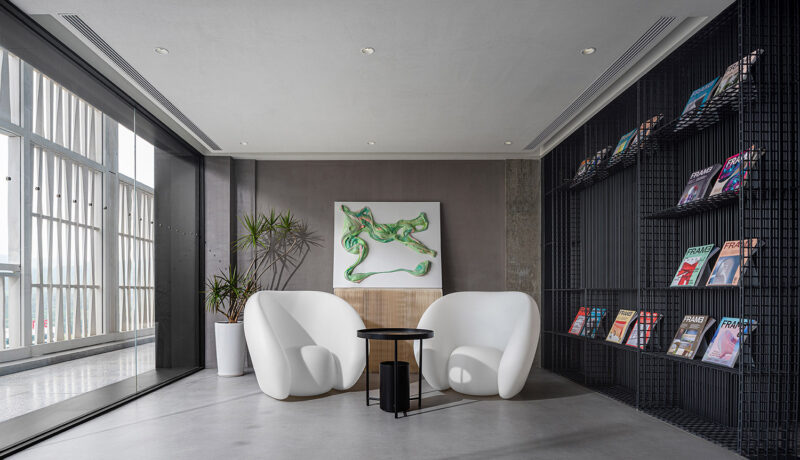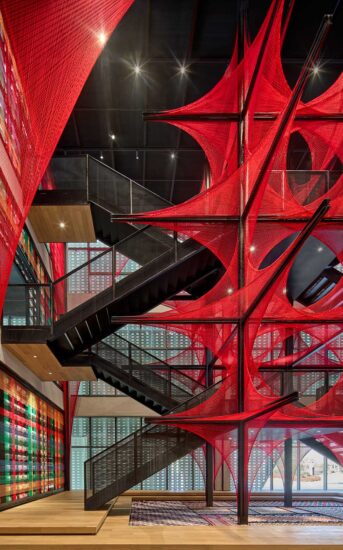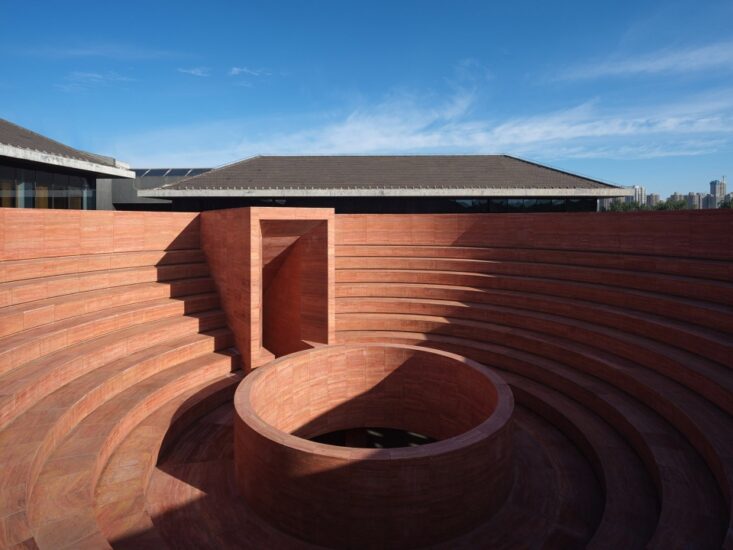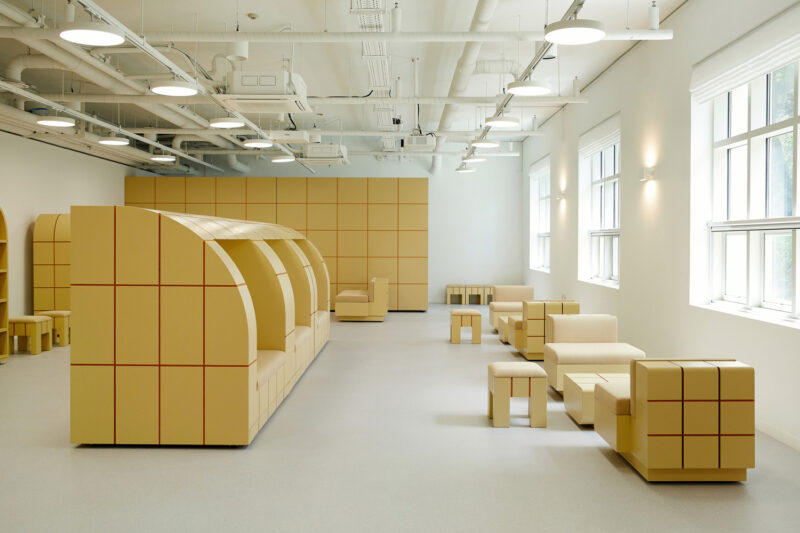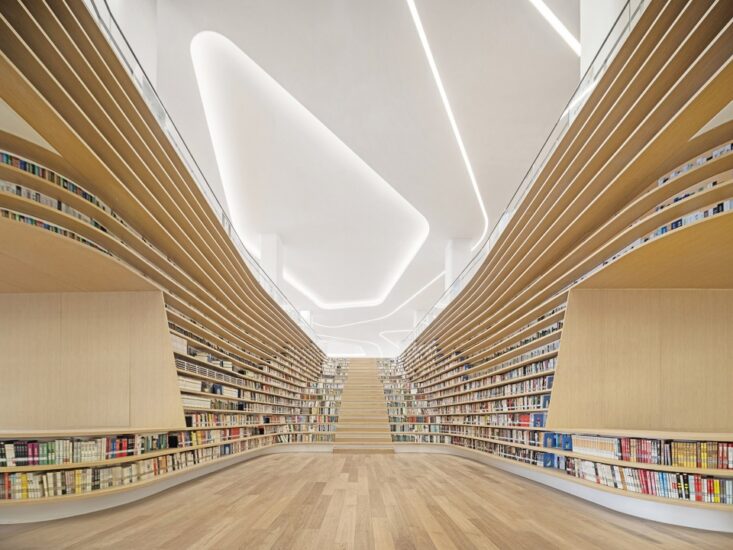寺中之館 A museum hidden in a temple
祖山木佛博物館位於秦皇島祖山風景區濟心寺,是一座特殊的寺廟博物館。濟心寺的曆史可追溯至宋代,它於半山之上遠眺著城市與渤海,遺世而獨立,是祖山風景區重要的旅遊節點。現狀寺院於2002年原址重建,寺院整體坐西向東、依山而建,形成三進院布局,博物館就坐落在寺廟建築群的最後一進。當遊客穿過大雄寶殿的回廊,可看到立於高台之上的三座大殿,分別為觀心閣、藥師殿及彌陀殿,即是木佛展陳的場館。
The Wood Buddha Statue Museum is located at Ji Xin Monastery in Zushan Scenic Area of Qinghuang dao City. With a history dating back to the Song dynasty (960-1279), the temple nestles half way up the mountain, overlooking the city and Bohai Sea like a hermit. As a major tourist spot of Zushan Scenic Area, the existing temple was rebuilt on its original site in 2002. Facing eastwards, the temple complex unfolds across the mountain terrain, forming a spatial layout in three courtyards. The museum is located at the back courtyard. As visitors navigate through a corridor of the temple’s main hall, they will see three halls standing on top of a high platform: the Guanxin Hall, the Hall of Medicine Buddha and the Hall of Amitabha Buddha, which are venues for the wood Buddha statue museum.
∇ 概念分析 © 建築營設計工作室 Conceptual diagram © Archstudio
作為博物館的主要展品,香樟木佛的來曆頗有淵源,原是日本收藏家赴浙江東陽定製的木佛雕像。佛像在日本輾轉幾十年,業主將其全部購回,並在反複思慮後,決定將其落戶在祖山濟心寺安置。改造之後的博物館將成為傳統寺廟功能的補充,在這裏,人們可以祈福靜心,可以觀賞雕刻藝術,也可以冥想禪修,感知中華文化的智慧和哲學。新的空間為遊客提供更為豐富、多層次的寺廟遊覽體驗。
The camphor wood Buddha statues are major exhibits of the museum. They hold an intriguing origin story as they were originally commissioned from Dongyang, Zhejiang Province by a Japanese collector. Over the course of several decades, these statues changed hands among different owners in Japan until the client decided to buy them back to China. After careful consideration, he decided to find them a new home at Ji Xin Monastery. Through space renovation, the museum has provided extra functions to the traditional temple. It has become a sacred space for prayer and inner reflection, a place to appreciate the artistry of sculpture, a sanctuary for meditation, and a venue to immerse oneself in the wisdom and philosophy of Chinese culture. The transformed space provides visitors with a diverse and enriching journey during their temple visit.
∇ 觀音雲台鳥瞰 © 金偉琦
Aerial view of Avalokitesvara Cloud Terrace © Jin Weiqi
殿外之台 A terrace outside a hall
由於大雄寶殿與木佛博物館之間有近十米左右的高差,原始場地中存有一處高陡突兀的台階連接上下,台階中部立有一尊觀音石雕立像。此處作為遊人進入木佛博物館的重要的前序空間,也一並考慮在本次設計更新的工作之中。
A significant elevation difference of nearly 10 meters separates the main hall and the wood Buddha museum, which are connected by an existing steep stairway on the site. In the middle of the stairway stands a stone Guanyin statue, marking a significant area that visitors pass through before they reach the museum. Thus, this area has also been involved in the renovation project.
∇ 觀音雲台主視角 © 金偉琦
Main view of Avalokitesvara Cloud Terrace © Jin Weiqi
新的設計在延續寺廟中軸線以及保留觀音石雕立像的前提下,對現有前區景觀進行改造提升。為了加強進入博物館的儀式感,前區景觀被設定為“雲台”,結合場地的高差條件,圍繞中心台階展開高度不一的七層水洗石階梯平台。設計同時擴大了觀音立像所在的休息平台,並將台階的坡度適當放緩,以便於人的行走與停留。雲台以柔美的曲線形態宛如祖山雲霧逐層漫延開來,平台之上附有噴霧設施、草坪以及點景鬆樹。當遊客穿過不斷變幻的水霧之雲拾級而上,心情也逐漸平靜下來,三座大殿才慢慢顯露其真身。
The new design encompasses enhancement of the landscape of the front area, on the premise of preserving the temple’s central axis and the Guanyin statue. To enhance the ceremonial experience before entering the museum, the front area landscape has been conceptualized as a “cloud terrace”. Leveraging the varying elevations of the terrain, the architects created seven sets of exposed aggregate concrete platforms on either side of the central steps, each differing in height. Furthermore, the design team has extended the area where the Guanyin statue stands and gently sloped the steps to ensure visitor convenience and comfort. The cloud terrace features an exquisite curving form, reminiscent of rippling mists encircling Zushan Mountain. Sprayers, a lawn, and pine trees adorn the platform. As visitors ascend the steps enveloped in ever-changing mist, they’ll gain a sense of tranquility before the three halls finally reveal themselves.
∇ 觀音雲台局部構造節點 © 建築營設計工作室
Detailed diagram of Guanxin Hall © Archstudio
∇ 觀音雲台主視角 © 王同輝
Main view of Avalokitesvara Cloud Terrace © Wang Tonghui
殿中之塔 A pagoda inside a hall
用於集中展陳木佛像的主殿是一座框架結構的仿宋式建築,大殿麵寬30米,進深16.8米,殿內設有兩層環廊及樓梯,圍合出中部挑空高度近20米的高大空間。如何結合不同尺度的木佛造像營造多層次的展陳體驗,並能夠適配舊有佛殿有限的空間,創造可觀、可遊的當代精神性場所,是本次設計考慮的首要問題。
The main hall for centrally exhibiting the Buddha statues is a Song-style building with a frame structure. It has a width of 30 meters and a depth of 16.8 meters. Two ring corridors situated on different levels, along with a stairway, enclose an area with a high ceiling of nearly 20 meters in the center of the hall. The primary consideration of the design is how to create a varying exhibition experience for visitors with wood Buddha statues of different sizes, while accommodating to the limited space of the original hall and turning it into a modern spiritual destination that’s worth visiting.
∇ 主入口視角 © 金偉琦 Main entrance view © Jin Weiqin
∇ 空間生成圖解 © 建築營設計工作室
Space generation diagram © Archstudio
設計借鑒了“塔”這一建築原型,在大殿中創造了一座空心佛塔,作為立體展陳木佛造像的主要載體。佛塔平麵呈橢圓形,共七層,逐層向上收束,彙聚於矩形的佛殿空間頂端。佛塔內部以曼陀羅作為意向。曼陀羅意為壇場,即一切聖賢、功德的聚集之所,代表了佛教文化的宇宙模型。
The design borrows from the architectural prototype of “pagoda”, creating a hollow Buddha pagoda in the center of the hall as the main carrier for a vertical exhibition of wood Buddha statues. Appearing oval in floor plan, the pagoda has seven layers that grow narrower upwards to meet at the square ceiling of the hall. The interior of the pagoda borrows the imagery of Mandala, a consecrated area where all the sages and men of virtues are brought together and a symbol of universe in Buddhism.
∇ 觀心閣A-A剖透視圖 © 建築營設計工作室
Section A-A of Guanxin Hall © Archstudio
∇ 工作模型 © 建築營設計工作室
Models © Archstudio
∇ 首層視角 © 金偉琦
First floor view © Jin Weiqi
佛塔首層以6米高的四麵千手觀音的坐像為中心,周邊錯疊環繞30尊觀音化身立像。結合佛像的尺度和位置設置了特定的佛龕——拱洞開口,以及由塔身延伸出的花瓣形底座來承托木佛。
On the first layer of the pagoda, a thousand-hand Guanyin statue sits in the center, surrounded by 30 varying Guanyin statues arranged in a staggered manner. Specific shrines are set up based on the scales and positions of the Buddha statues. Each with an arched opening, the shrines provide home to the statues situated on petal-shaped pedestals.
∇ 塔內仰視 © 金偉琦
Bottom view of the pagoda’s interior © Jin Weiqi
∇ 塔內視角 © 金偉琦
Interior view of the pagoda © Jin Weiqi
∇ 塔內主視角 © 王寧
Main view of the pagoda’s interior © Wang Ning
佛塔在五至七層集中展示聖觀音造像。第五層中心位置為兩尊聖觀音的坐像。為了突出中心感和懸空感,設計采用張弦梁結構,並輔以蓮花座等裝飾杆件,在塔身內部形成一層漣漪擴散的景觀。最小的聖觀音像被置於第六、七層,匹配製作了枝葉般的金屬支架展陳。塔的頂端結束於層層退暈的光線。至此,當遊人於塔內駐足觀賞,如花瓣般的佛座層層彙集於頂端的一處光明,萬象森列、圓融有序,構建出崇高、無盡、深遠的禪境。
Most of the Guanyin statues are exhibited on the fifth to seventh layer of the pagoda, and two Arya-avalo Kitesvara statues sit in the center of the fifth layer. To highlight a sense of centrality and suspension, the design adopts a beam string structure and ornaments such as lotus-shaped pedestals, to create a visual effect of ripples spreading within the pagoda. The smallest Guanyin statues are placed on the sixth and seventh floor with specially crafted metal frames that look like tree branches. The top of the pagoda culminates in layers of fading light. As visitors linger and admire inside the pagoda, they’ll find petal-shaped pedestals gather all the way to a well-lighted place on the top. Everything is arranged in an orderly and harmonious manner, creating a sublime, boundless and profound Zen ambience.
∇ 塔內仰視 © 王寧
Bottom view of the pagoda’s interior © Wang Ning
∇ 結構圖解 © 建築營設計工作室
Structure diagram © Archstudio
∇ 塔內細部 © 王寧
Interior details of the pagoda © Wang Ning
佛塔也催生了轉塔這一具備祈福意味的環遊路徑。將已有建築改造為首層、夾層環廊和頂層三個可以供人遊走的平台,形成立體環遊路徑。首層塔身外側書寫有金剛經,可在轉塔過程中細細品味。同時在首層大殿左右兩側設置了6尊觀音化身立像供人祭拜。原有樓梯被適當的改造,將遊人引向頂層。
The pagoda offers visitors the opportunity to engage in a circumambulation, a path that provides prayer experience. The renovation also includes the transformation of three platforms that allow visitors to walk around. These platforms consist of a ground-floor ring corridor, a mezzanine-floor ring corridor, and a top-floor platform, creating a vertical circulation pattern. On the exterior walls of the pagoda’s first layer, the Diamond Sutra is inscribed, providing visitors with the opportunity to contemplate the teachings of the sutra as they circumambulate the pagoda. Additionally, six standing Guanyin statues are positioned on both sides of the first layer of the hall for visitors to worship. The original stairway has been modified to guide visitors to the top floor.
∇ 工作模型 © 建築營設計工作室
Models © Archstudio
∇ 首層視角 © 金偉琦
First floor view © Jin Weiqin
∇ 回廊視角 © 王寧
Ring corridor view © Wang Ning
∇ 頂層視角 © 王寧
Top floor view © Wang Ning
設計圍繞流線設置五處投影,分別展示觀音手勢、觀音四大修行地等內容,進一步豐富遊客的觀覽體驗。頂層為11米高的環形平台,這裏是最高點,可以俯瞰遠山。
Along the circulation route, five projection positions are set to showcase content related to the gestures and the four sites where Guanyin practiced for Buddhism, enhancing the overall visiting experience. At the highest point of the pagoda, there is a circular platform with an 11-meter-high ceiling, allowing visitors to enjoy a panoramic view of the distant mountains.
∇ 觀音手勢 © 建築營設計工作室
Guanyin gesture © Archstudio
∇ 修行場景 © 建築營設計工作室
Scenes of Guanyin practiced for Buddhism © Archstudio
∇ 回廊視角 © 金偉琦
Ring corridor view © Jin Weiqin
室內環境照明也做了相應的匹配設計。在自然光較暗的環境中,人工照明才能更好地營造出空間的靜謐感。建築外側玻璃上粘貼了透光率為9%的透光膜,減少自然光量進入。塔身全部采用隱藏式照明,用燈光勾勒出建築的結構美感。
The interior ambient lighting is carefully tailored to the specific environment. Artificial lighting can better create a sense of tranquility only in an environment with limited natural light. To control the amount of natural light entering the building, a translucent film with a transmittance of 9% is applied to the exterior glass surfaces. The pagoda’s structural beauty is accentuated through the use of concealed lighting, which illuminates the building’s form.
∇ 塔內視角 © 王寧
Interior view of the pagoda © Wang Ning
∇ 塔內細部 © 王寧
Interior details of the pagoda © Wang Ning
塔尖的穹頂設置了三層燈槽,燈槽的顏色逐層變淺,從而營造出漸變的向上的感覺。設計團隊在倉庫中做了多輪照射角度、光束大小、照度和距離的測試實驗,最終保證每一尊佛像均有較好的照明效果。
At the dome of the pagoda, three layers of lighting troughs are installed, with each layer gradually transitioning to a lighter color. This arrangement creates an upward transition of lighting effect. To ensure optimal lighting effects for each Buddha statue, the design team conducted extensive testing in a warehouse, taking into account various factors such as illumination perspective, beam size, illuminance, and distances.
∇ 塔內夾層 © 金偉琦
Mezzanine floor of the pagoda © Jin Weiqin
∇ 塔內夾層 © 王寧
Mezzanine floor of the pagoda © Wang Ning
館外之堂 Halls attached to the museum
博物館兩側的耳殿被定義為講經堂,是博物館公共教育活動的重要補充。設計利用了耳殿建築近 11 米的高度特點,在靠近天花的位置懸置四麵發光經文金屬板,並利用鏡麵反射材料進一步拔高了空間,營造出亦真亦幻、頗具未來感的藝術空間氛圍。四周牆體均為暗色吸音板,為講經堂營造了良好的光學與聲學環境,補足了博物館的功能和精神屬性。
The side halls in the museum are designated as Sutra Halls, playing a crucial role in the museum’s public education activities. The design capitalizes on the height of these halls, approximately 11 meters, by installing luminous metal boards adorned with inscribed sutras that hang around the hall and reach close to the ceiling. The use of mirror-surfaced materials creates an elevated ambience within the space, and imbues it with an otherworldly, futuristic sense of art. Additionally, the walls are constructed with sound-absorbing panels, optimizing the lighting and audio conditions of the lecture hall, while further augmenting the museum’s functionality and spiritual essence.
∇ 講經堂A-A剖透視圖 © 建築營設計工作室
Section A-A of Sutra Hall © Archstudio
∇ 講經堂主視角 © 金偉琦
Main view of the Sutra Hall © Jin Weiqin
∇ 講經堂 © 王寧
Sutra Hall © Wang Ning
∇ 講經堂細部 © 金偉琦
Details of the Sutra Hall © Jin Weiqin
結語
博物館設計融合了室內、展陳、雕塑、影像、景觀等多種藝術門類進行綜合呈現。從曼陀羅、浮屠等宗教意向出發,以當代全新的方式詮釋了佛文化藝術的精神魅力,讓人們沉浸其中,遊曆、靜思、冥想,回顧自己的內心世界。
The museum design seamlessly combines various art forms, such as interior design, display, sculpture, visual art, and landscape, to create a comprehensive work of art. Drawing inspiration from religious symbols like Mandala and Bodobudur, the design interprets the spiritual essence of Buddha culture and art in a contemporary and innovative way. It aims to provide visitors with an immersive meditative experience, inviting them to explore their inner world while visiting around the space.
∇ 施工過程圖解 © 建築營設計工作室
Construction process © Archstudio
∇ 總平麵圖 © 建築營設計工作室
Master plan © Archstudio
∇ 觀心閣首層平麵圖 © 建築營設計工作室
Ground floor plan of Guanxin Hall © Archstudio
∇ 觀心閣夾層環廊平麵圖 © 建築營設計工作室
Mezzanine ring plan of Guanxin Hall © Archstudio
∇ 觀心閣頂層平麵圖 © 建築營設計工作室
Top floor plan of Guanxin Hall © Archstudio
∇ 講經堂平麵圖 © 建築營設計工作室
Plan of Sutra Hall © Archstudio
項目信息
項目名稱:祖山濟心寺·木佛博物館
項目地點:秦皇島祖山濟心寺
業主方:青龍滿族自治縣祖山新朝旅遊發展有限公司
設計方:建築營設計工作室
主持設計師:韓文強
項目設計師:王同輝
室內設計:王同輝、曹衝、魏傑、徐也(駐場設計師)
景觀設計:王同輝、曹衝、韓飛
照明谘詢:董天華
結構谘詢:張勇
機電谘詢:江茂、鄭寶偉
導視設計:王同輝、劉璿
雕塑配合:秦華勤
施工單位:中建八局
建築麵積:1657平方米
設計時間:2019.12——2020.10
建造時間:2020.11——2022.03
攝影及攝像:王寧、金偉琦、肖石明
Project name: Zushan· Ji Xin Monastery· Wood Buddha Statue Museum
Location: Ji Xin Monastery, Zushan Scenic Area, Qinghuangdao
Client: Zushan Xinchao Tourism Development Co., Ltd.
Design firm: Archstudio
Chief designer: Han Wenqiang
Designer: Wang Tonghui
Interior design: Wang Tonghui, Cao Chong, Wei Jie, Xu Ye (On-site designer)
Landscape design: Wang Tonghui, Cao Chong, Han Fei
Lighting consulting: Dong Tianhua
Structural consulting: Zhang Yong
MEP consulting: Jiang Mao, Zheng Baowei
Signage design: Wang Tonghui, Liu Xuan
Sculpture consulting: Qin Huaqin
Construction: China Construction Eighth Engineering Division Corp., Ltd
Gross floor area: 1,657 sqm
Design phase: Dec. 2019 – Oct. 2020
Construction time: Nov. 2020 – Mar. 2022
Photography: Wang Ning, Jin Weiqi, Xiao Shiming


